1lumen selects and reviews products personally. We may earn affiliate commissions through our links, which help support our testing.
Mateminco MT-911 review
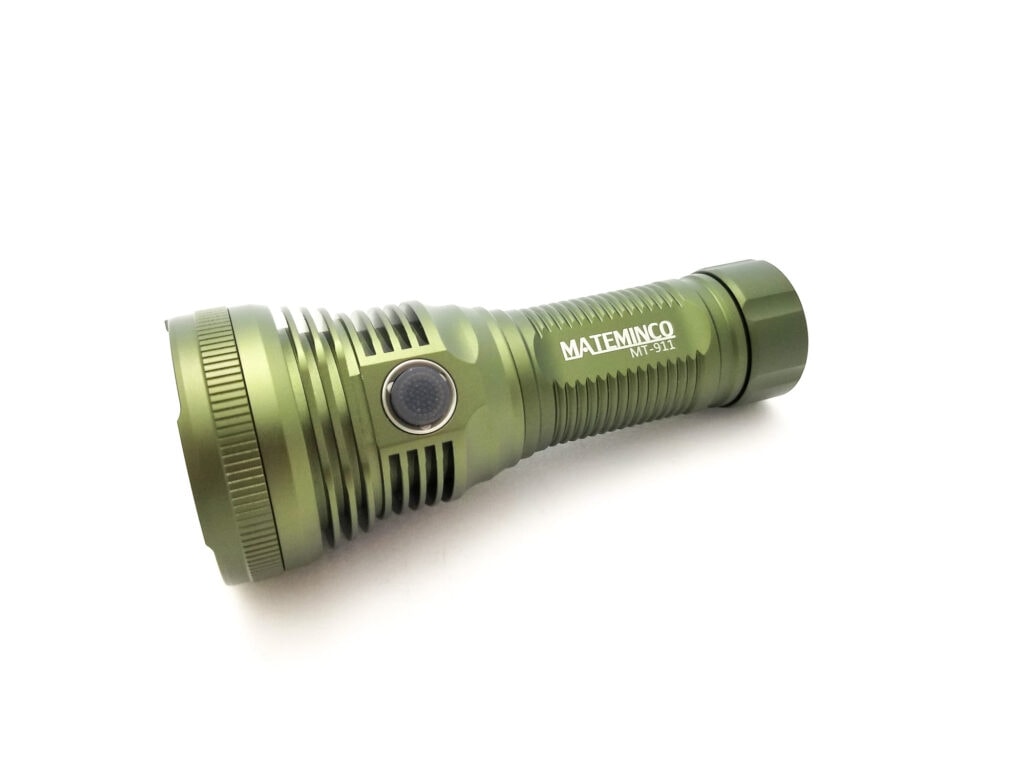
Mateminco MT-911 specs
| Brand & Model | Mateminco MT-911 |
|---|---|
| Flashlight category | Long-range flashlight |
| LED | XLD-G90 |
| Max. output | 6,200 lumens |
| Max. beam distance | 916 meters |
| Max. beam intensity | 210,000 cd |
| Battery config. | 1×26650 or 26350 |
| Onboard charging | Onboard USB type C |
| Modes | Custom ramping UI |
| Blinkies | Strobe |
| Waterproof | IPX6 |
| Review publication date | May 2023 |
Review intro:
Another Mateminco! So far this is the second Mateminco product to land on my desk. The last one, the Mateminco LT40, barring the custom ramping UI, was a mirror image of the Astrolux EA01S. This is a trend amongst some brands, made most prevalent in the automotive industry where offshoots of parent brands are produced for various markets, trims, and branding. This extends into the flashlight world also, where hosts are shared across product lines with slight alterations between them.
This Mateminco, however, breaks that cycle since it’s all new design and form factor, and not shared with any other branding. There’s only some minor continuities from existing designs, which I’ll go into later.
The subject today is the Mateminco MT-911. This is a compact high output thrower flashlight. It has all the requisite features of a modern, enthusiast light like onboard charging and features another mysterious Chinese-made LED. I won’t spill the beans on it yet, but it’s a clone of another very popular LED. The MT-911 comes by way of flashlightbrand.com, so another big thanks to them for sending this out. I didn’t have the best experience with the LT40, so I’m hoping this one is better. It promises some impressive specs: 6200 Lumens and 900+ meters of beam distance certainly puts it amongst the top class pocket throwers, but it has some very stiff competition.
Read on for more.
Package quality.
The MT-911 came in the same white on white, delightfully elegant but simple package with an outer sleeve that slides off to reveal a sturdy box with a lift-off lid like the LT40. I’m not sure why Mateminco insists on using silver text and graphics on a white background though since it’s only somewhat legible, and even worse under bright light (which makes it tough to photograph). Here’s what you get:
- Mateminco MT-911 flashlight
- Lanyard
- Manual
- Warranty card
- 26350 battery tube
- Standard 26650 tube
- USB type A to C charging cable
- 2 spare o-rings
- Unbranded 2000 mAh 26350 li-ion battery
- Mateminco branded 5000 mAh 26650 li-ion battery
- Glow in the dark silicone diffuser
- Red and blue silicone diffusers
The phrase everything but the kitchen sink comes to mind here since this is a very comprehensive assortment of accessories and represents the second of two kits Flashlightbrand sells with the MT-911. Kit one is just the light, some o-rings, and a lanyard, so I really recommend dropping the extra $12 for kit two. It’s ready to run with both the 26650 and 26350 batteries included. The diffusers are a nice added bonus, and I’m not sure if they come standard or not. The opaque silicone diffuser glows in the dark and was installed over the head of the light out of the box. The red and blue diffusers were separate and loosely packed.
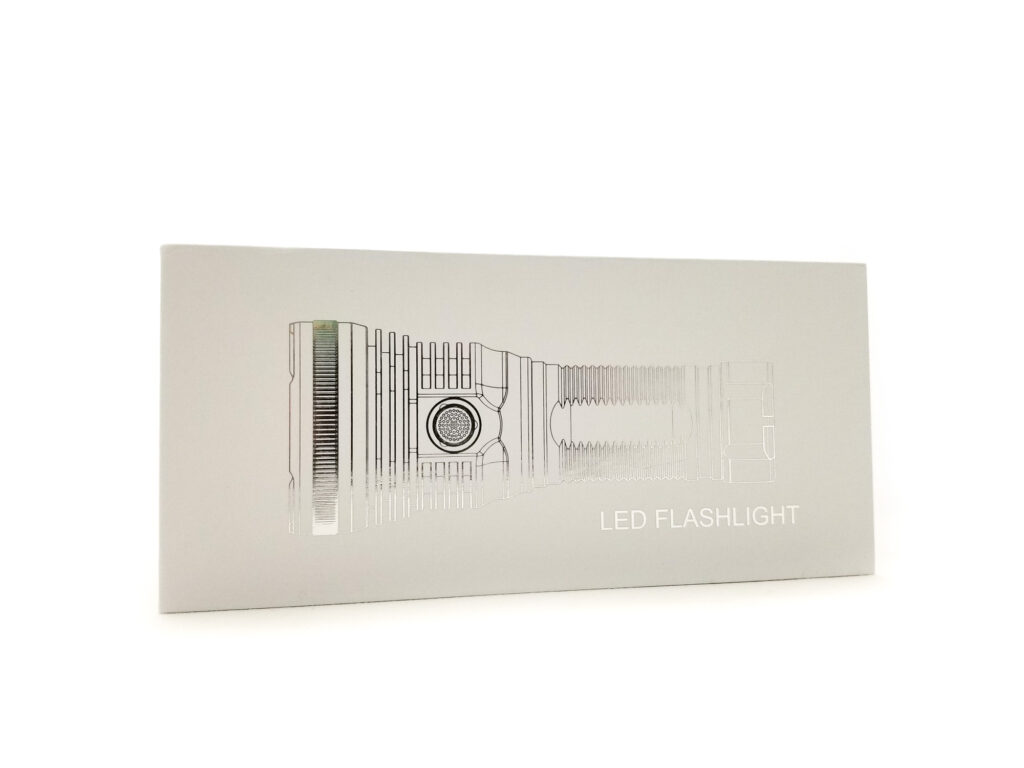
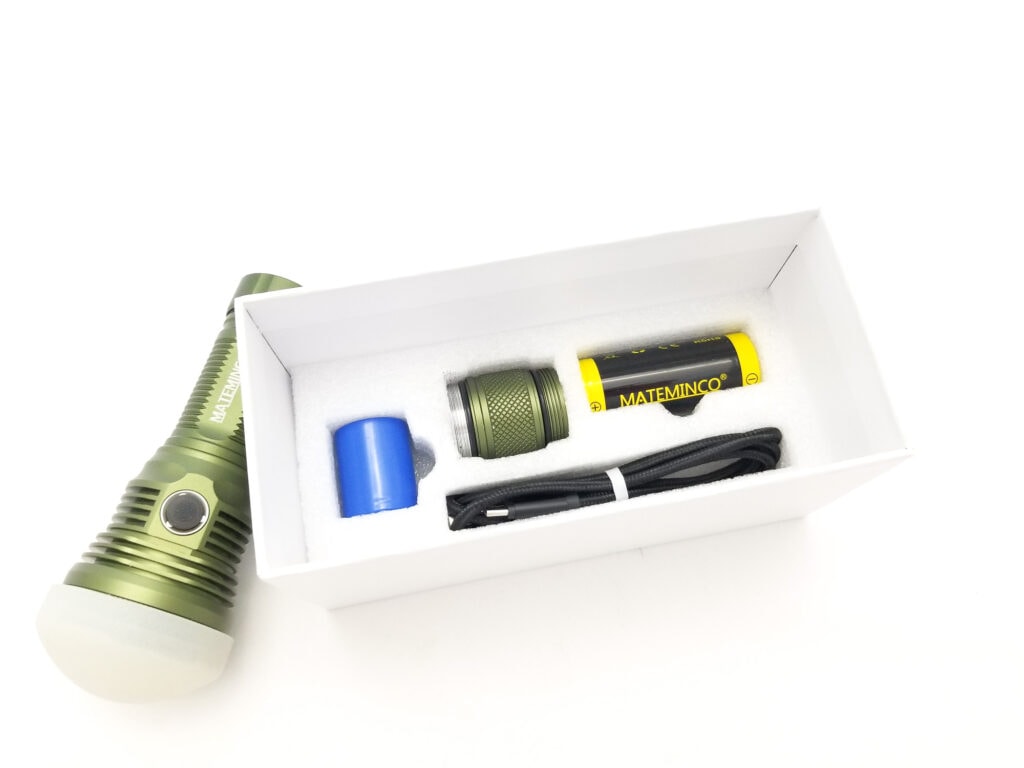
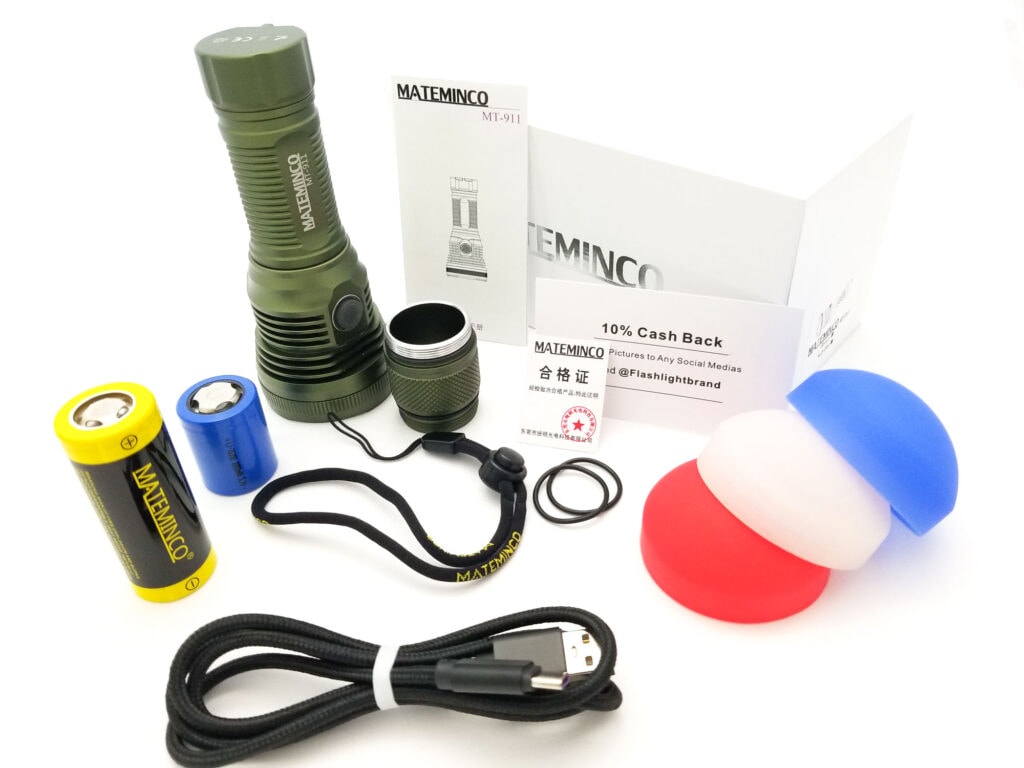
Flashlight in use
The MT-911 is a high output thrower flashlight, but it can also moonlight as a pretty nice general purpose light that can be called upon for a variety of tasks. Make no mistake: It’s a lot of light in a small package. The light is compact, and the 26650 tube has more girth than a 21700 size tube, but not overly so, and the ribbed texture on the tube aids in excellent grip. Switching to the shorty 26350 tube makes it shorter, stubby, and a bit odd-looking, but doesn’t upset the handling and makes it a bit more pocketable.
Mateminco also retained the magnetic tailcap with the MT-911, and while I think it’s a bit superfluous on a light like this, I would imagine it improves utility a bit. Unlike the LT40, this light didn’t include a 21700 nor the 18650 adapter tubes, but the ones from the Astrolux lights fit just fine. There’s a lanyard hole on the tailcap, and it’s unfortunately a bit small, so once again, unless you’ve got fingers like Tinkerbell, you’ll be using a tool to thread it. There’s no pocket clip to be found, but I think that’s okay since this isn’t a light I’d pocket carry anyway since it’s a bit too portly. There’s a single side e-switch for switching duties. It has a silicone boot that’s pretty grippy and has LEDs underneath for on state and charge state. They do not stay lit on standby, but do light up during operation (green or red based on battery state) and charging.
The switch action is snappy and has good feel and feedback, identical to the Mateminco LT40. It’s not the easiest to find by feel though, but with practice it gets easier. Opposite the switch is the USB type C charging interface, covered with a silicone rubber plug. Tail standing is no problem, and important if you include a diffuser for use as a lantern. It will roll off an inclined surface.
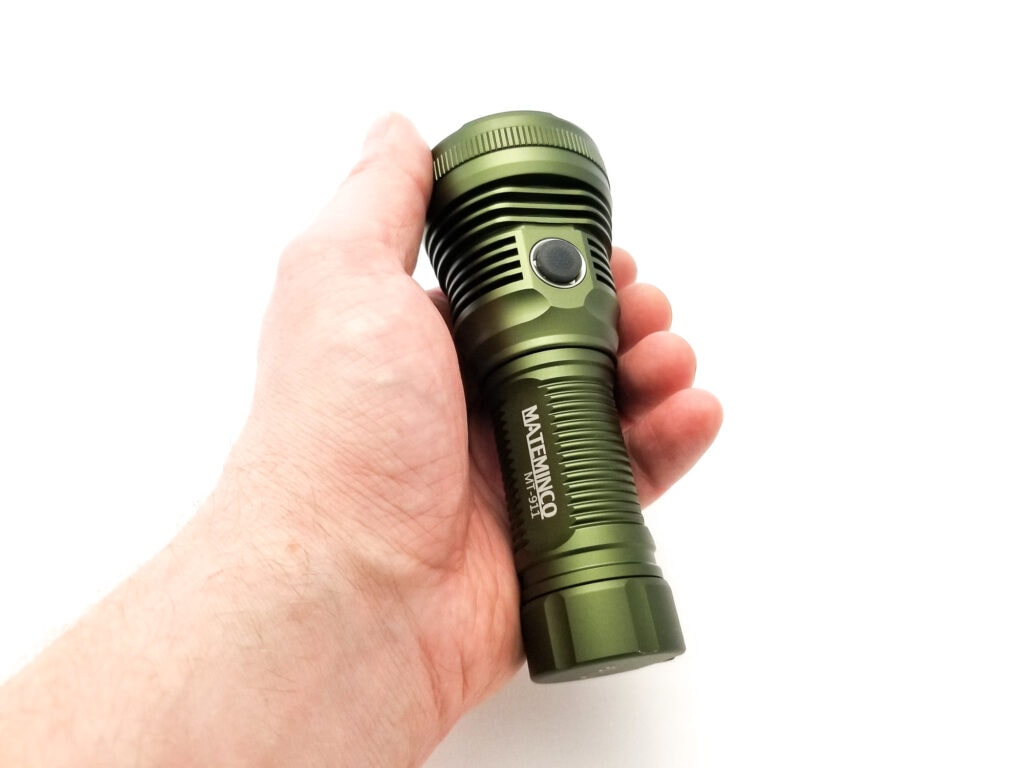
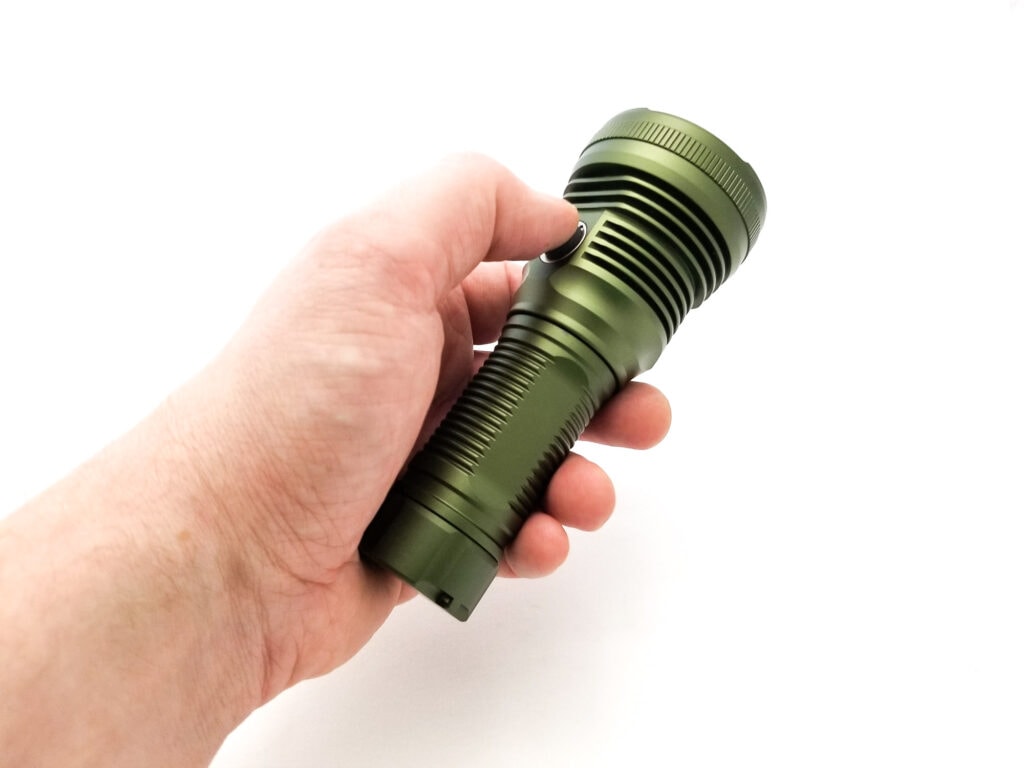
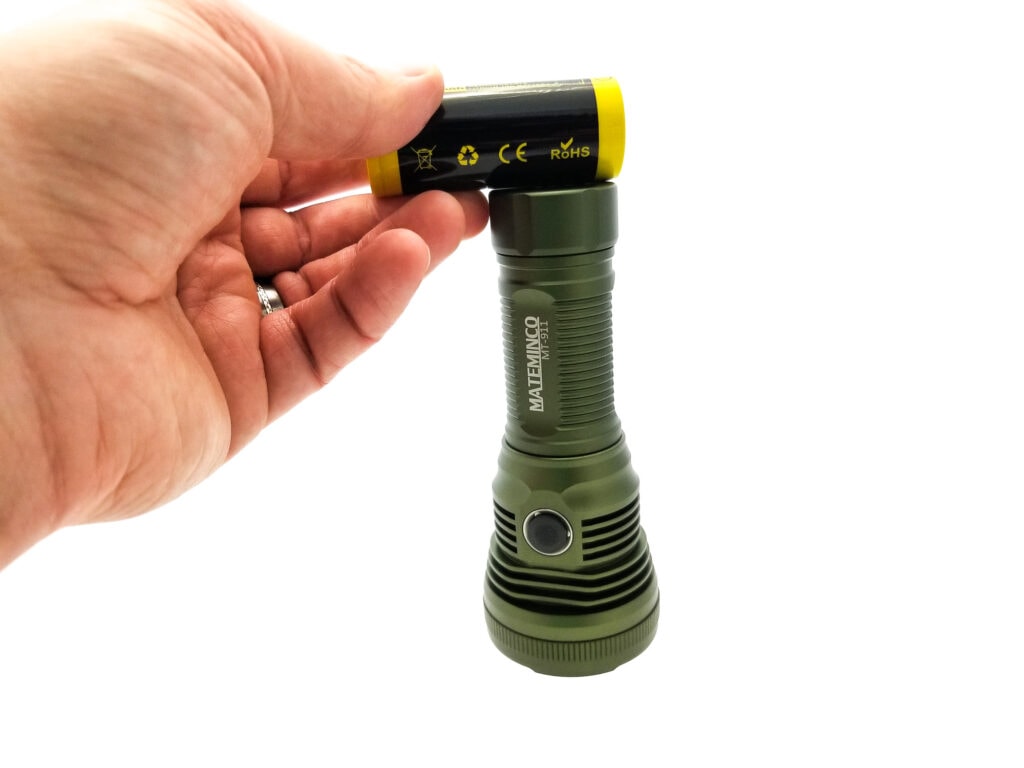
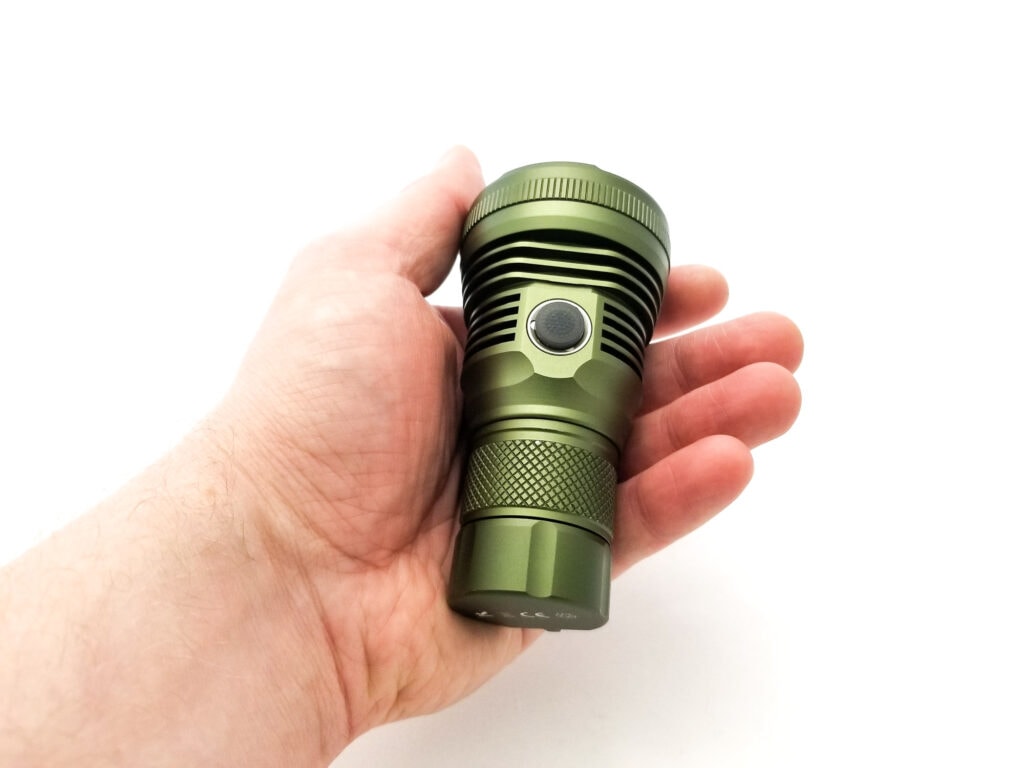
Build Quality and Warranty
My first experience with a Mateminco light in the LT40 was positive. It was of very good quality, fit, and finish, and it’s the same with the MT-911. I’d say it’s about what you expect in this price bracket, and maybe a bit more, making it a great value. Street prices range between $65-$70.
It passes the maracas test fine, there’s no anomalous gaps or misaligned parts, everything lines up nicely, and the machining is free of defects or tool marks. The bezel is aluminum this time and finished in the same color as the light. It has reeding along the periphery for gripping (and aids in removing the bezel). Mateminco says it’s milled from aluminum alloy, so probably 6061-T6.
The finish is advertised as type III HA, and it’s nicely done, with no defects, thin spots, or weird colors. It comes in two colors, black a muted camo green shade. My review light came in the good looking green color. The anodizing is marketed as type III HA, and it’s decently matte, but not chalky. It has even coverage with no blemishes or mismatched colors. All the edges are knocked down and smoothed as well, with the exception of the lanyard cutout, which had a bit of an abrupt edge. If you fancy to do so, the bezel can be unscrewed by hand and you can liberate the lens, reflector, and an o-ring.
The driver is held in with a retaining ring, and uses a brass pad for the positive contact. The battery tube cap has a double spring for a low-resistance current path. This (at least the spring’s PCB) is a carryover and familiar feature across both Mateminco and Astrolux lights I’ve tested, consisting of a long outer spring and thinner inner spring. The longer spring is supposed to help with accommodating an 18650 battery, but since this light didn’t include the adapter tubes, I think they could have redesigned the battery tube to be a bit shorter. The threads on the tailcap side of the tube are fully anodized, rectangular cut and pretty smooth, but the head end are much shorter, bare, and triangular cut with finer pitch threads.
Both ends are o-ring sealed, and if you’ve got an Astrolux FT02S, EA01, or EA01S, you can Lego this thing to your heart’s content since the tubes and tailcaps are interchangeable. For ingress protection, Mateminco gives it an IPX6 rating, and the X can be any number you want, but I think this light would be okay for temporary immersion or heavy rain since the charge port cover makes a tight seal.
For the warranty, it’s doled out by Flashlightbrand, so I’ll let them break it down: 1. 30 days free replacement. Flashlightbrand will replace or repair products with manufacturing defects within 30 days of purchase.
2. 5 years free repair: Flashlightbrand will repair the products free of charge within 5 years (accessories 1 year, products with built-in battery 2 years)of purchase if problems develop with normal use.
3. Lifetime warranty: If repair is required after guaranty period, we’ll charge for parts accordingly.
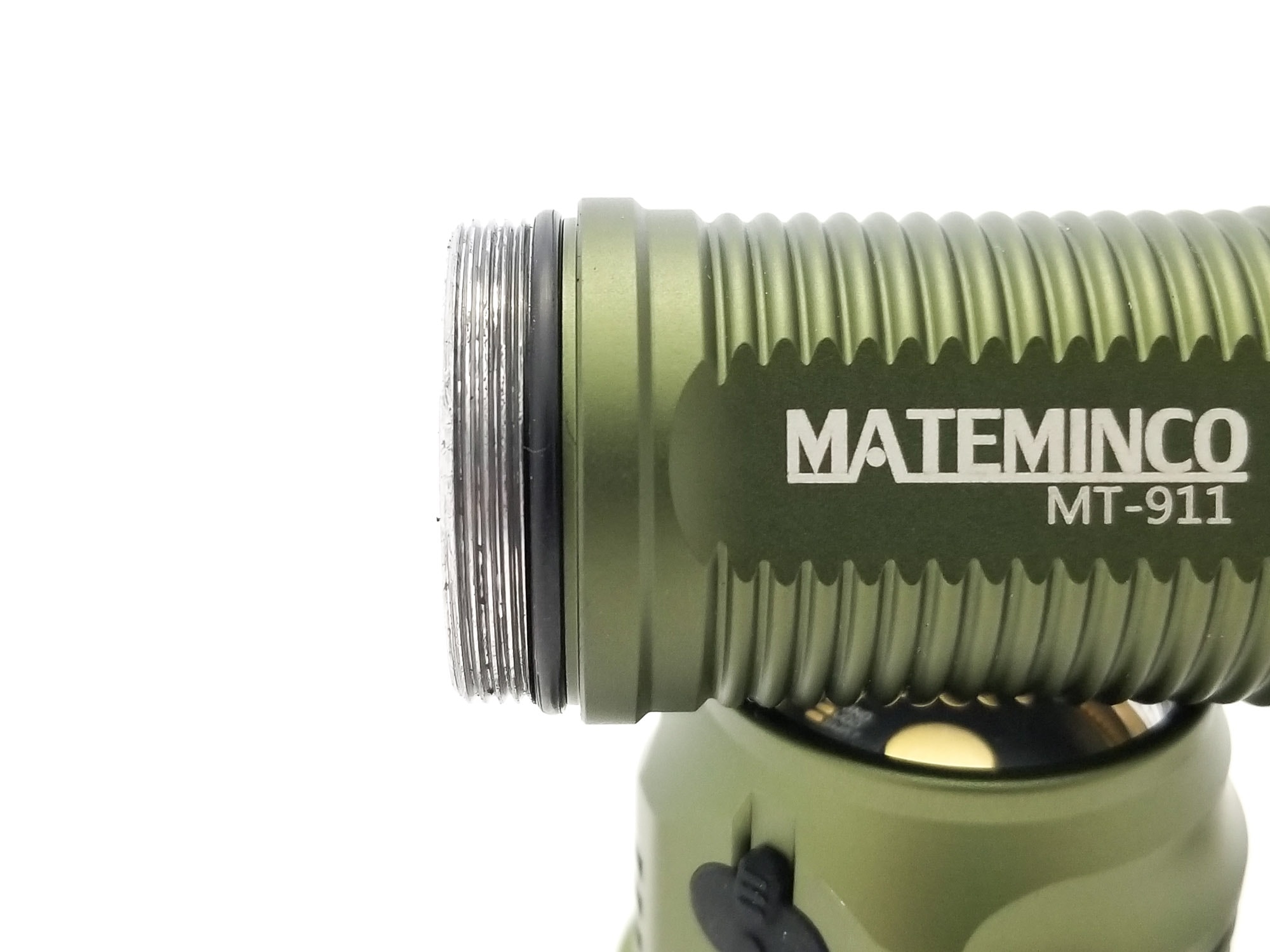
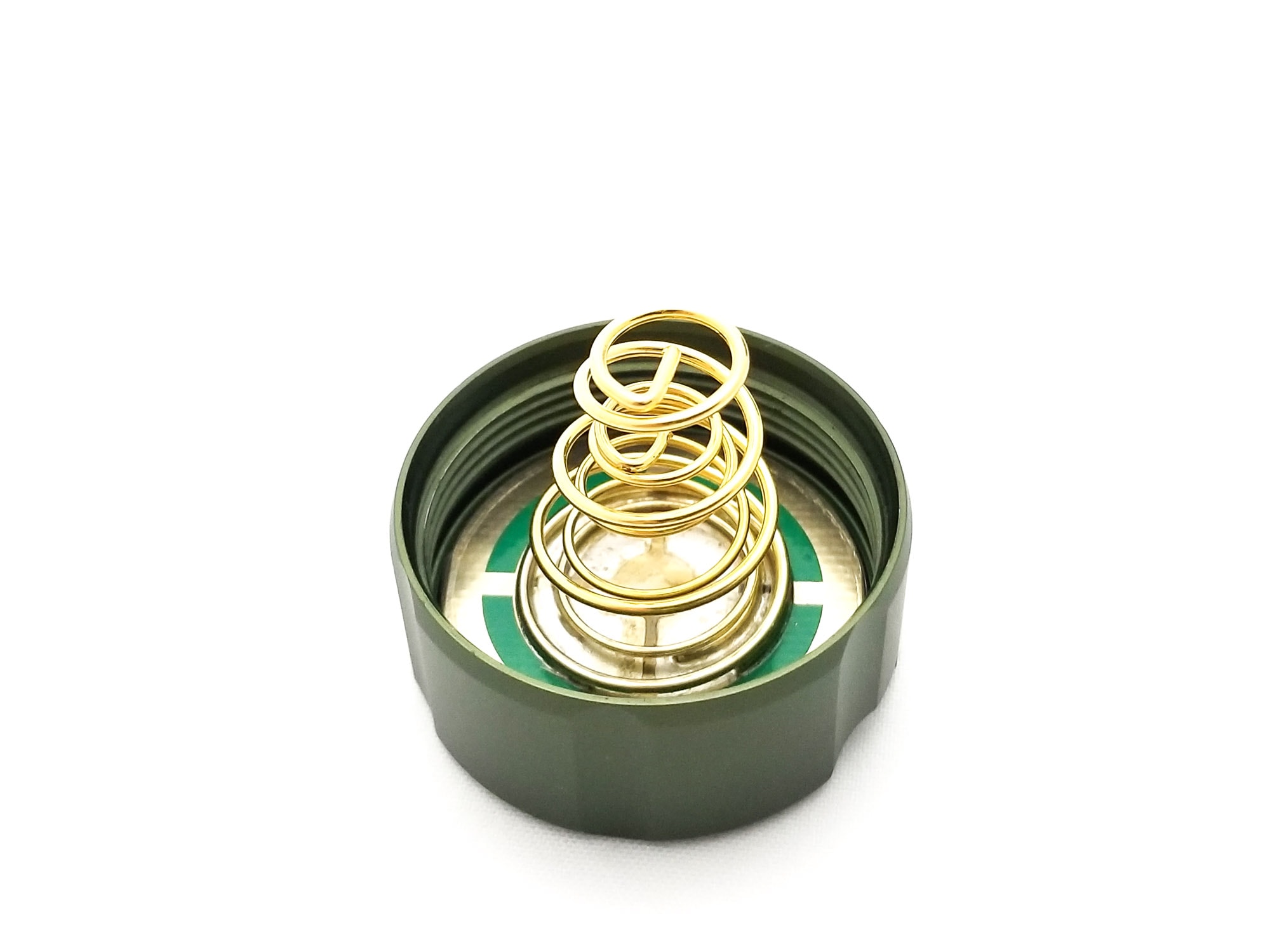
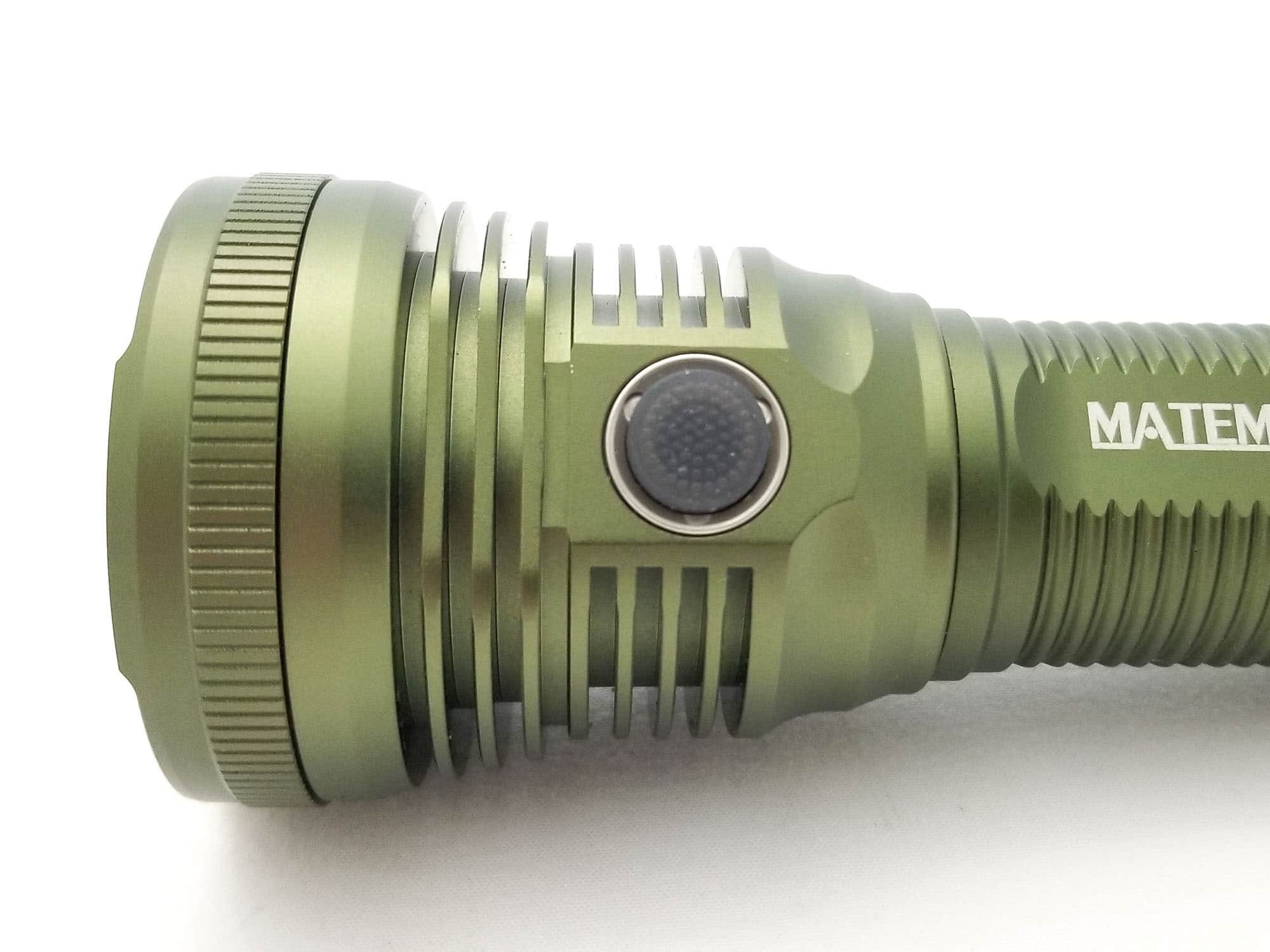
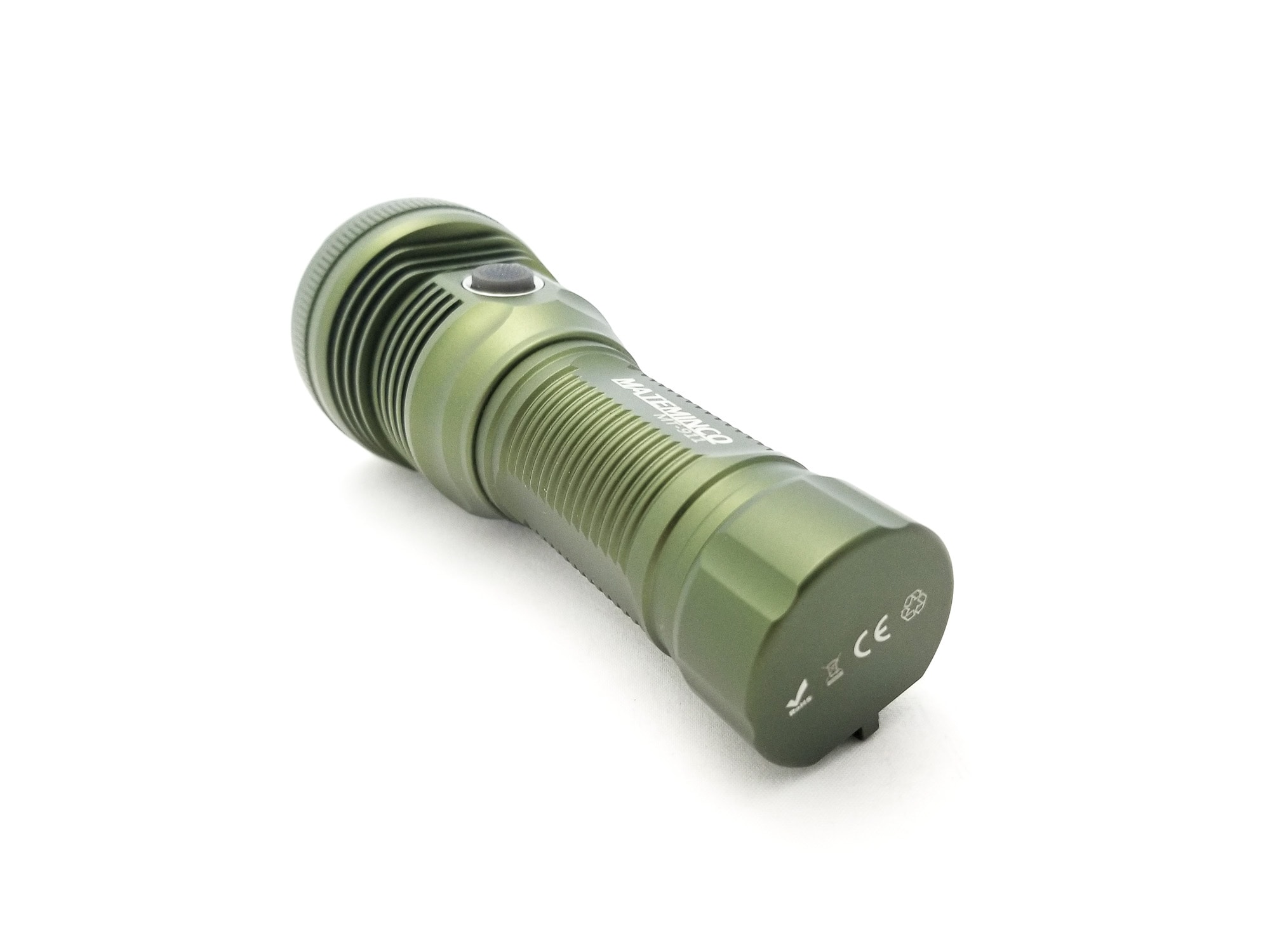
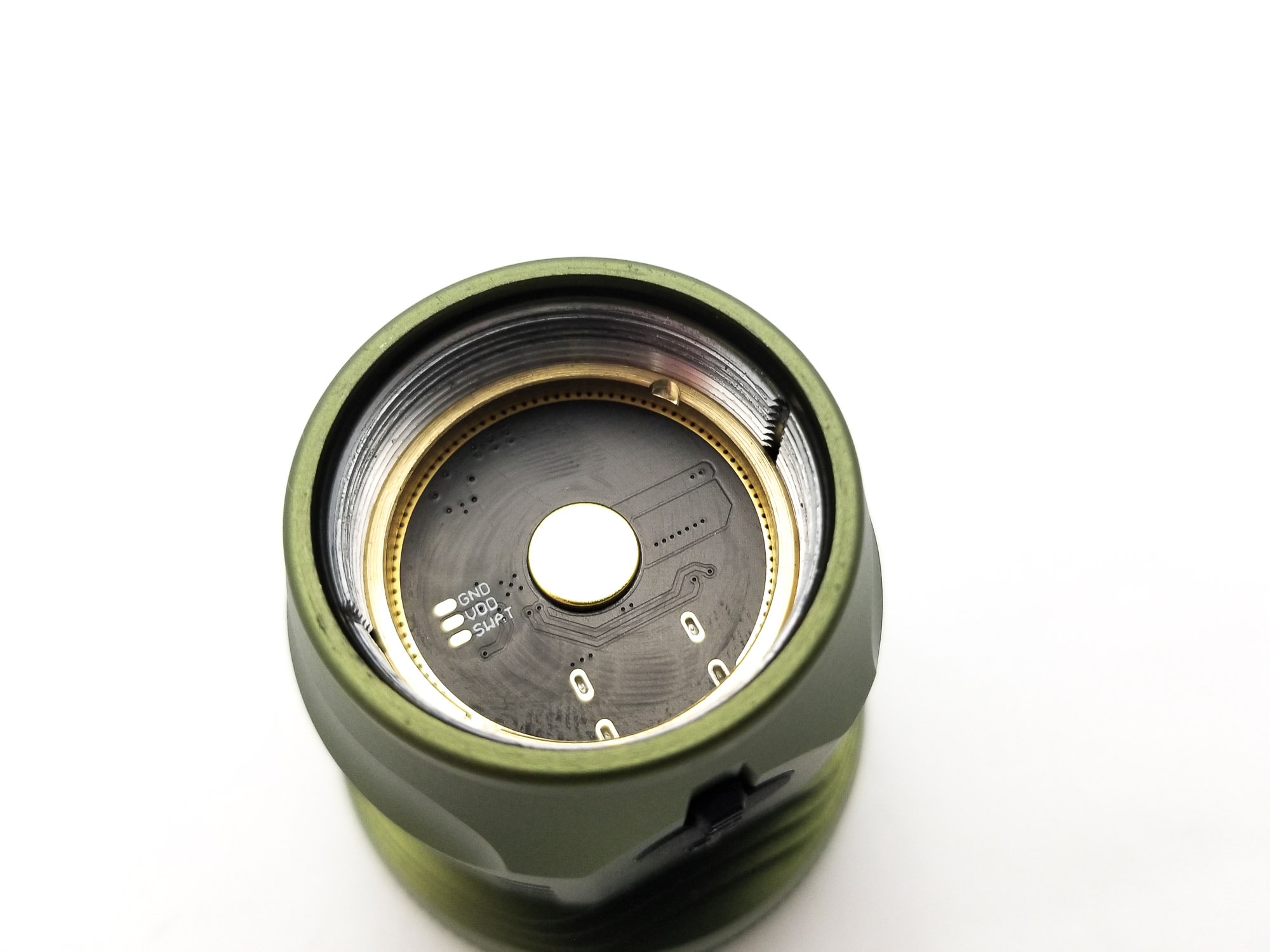
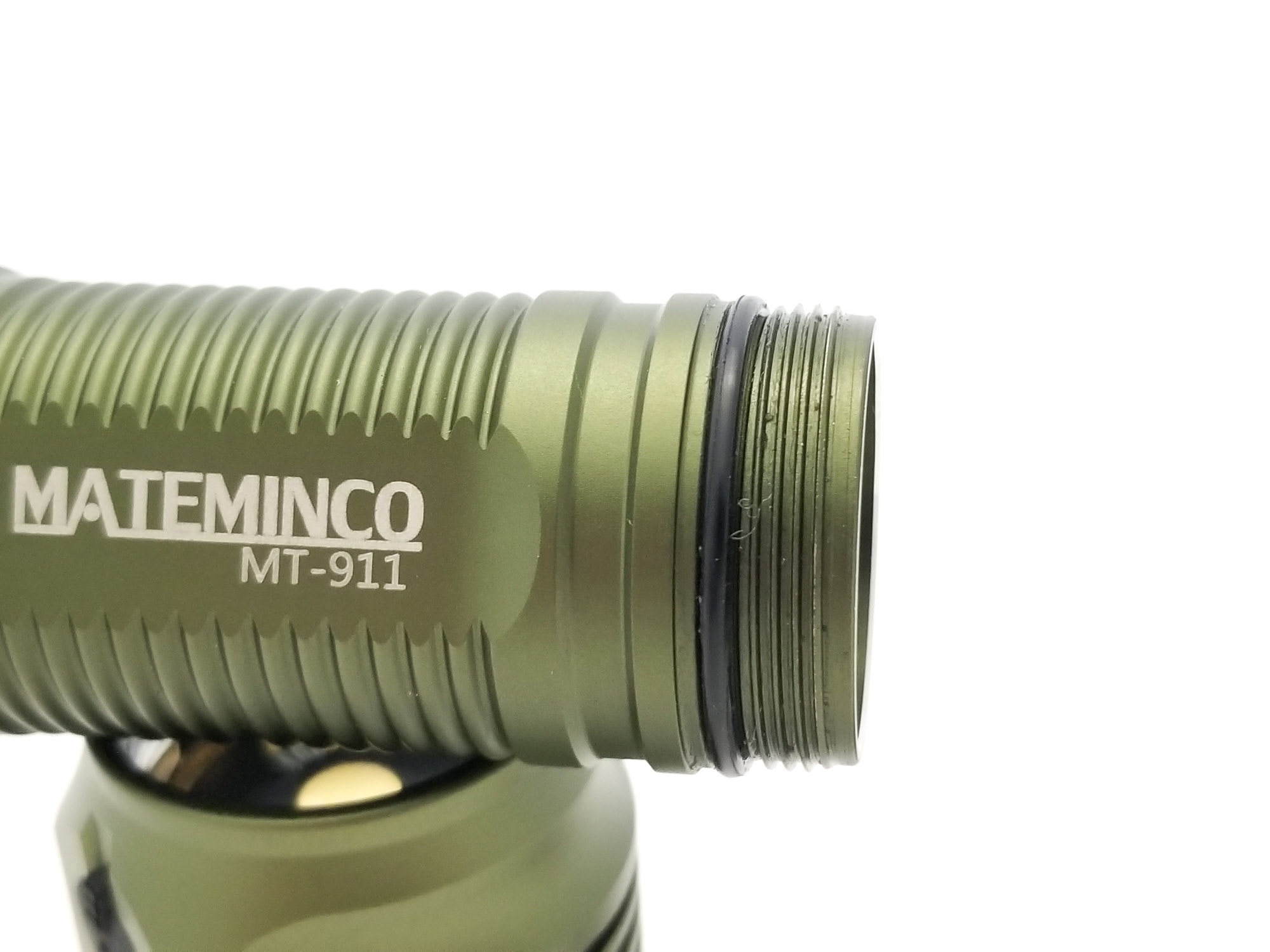
LED, Lens, Bezel, Beam, and Reflector
The LED department is where the MT-911 gets a bit mysterious since it features an LED that shares a design ‘borrowed’ from another, very popular thrower LED (bonus points if you can guess which one). It’s dubbed the XLD-G90, and it’s more or less a copy of the Luminus SBT90.2 LED, which needs no introduction.
There are other clones of the Luminus LED floating around out there, gracing lights like the Nealsgadgets NlightD T90, and the Haikelite HT90 as the GT-9090. There’s no datasheets and my web searches turned up zero information on this LED. It’s nearly identical to the SBT90.2, save for some differences keen eyed enthusiasts might notice like the white-color substrate. This is an 11×11 footprint LED.
It’s domeless and retains the same tiny AR coated glass lens covering the LES, and features the same bond wire design, with 12 bond wires for the anode and cathode. The 3×3 mm LES is homogenous and very uniform, which lends itself to very high luminance and great cd/mm2 which is important for throwers. I wish I could tell you about the voltage characteristics, thermal resistance, or binning, but I can’t. I do know it’s a 3 volt LED, and can be run off a single li-ion battery. When direct-driven, it should give very good output, but we’ll see since these Chinese LEDs are hit and miss for consistent performance. They’re usually not up to the same quality and consistency as the name brand LEDs, and sacrifice characteristics like thermal resistance, tint, and efficacy all in the name of cost-cutting. I don’t know what this XLD-G90 retails for in China, but it’s not for sale here, so who knows. The SBT90.2, bare, sells for around $40 US.
The aluminum bezel is the same color as the light, and has reeding on the periphery and extends a bit above the lens for some protection, but not much. The reflector is interestingly a OP unit. I was expecting an SMO reflector for maximum throw, but it seems Mateminco designed this as more of an all-around light that may moonlight as a quasi- thrower. That XLD-G90 LED is perfectly centered at the base of the reflector with a white centering gasket. The reflector is topped with an AR coated tempered glass lens. The beam is very uniform, and has a good amount of diffuse spill and a big hotspot that blends in very well with the spill. This beam is pretty versatile, and less of a thrower beam. For tint, on Turbo at 2 meters from the sensor, the Opple lightmaster Pro has it at:
- CCT: 6510K
- CRI Ra: 66
- Duv is 0.0058.
It’s not at all intrusive, and fits well to the application. The SBT90.2 comes in around 5700K and 71 RA, so a bit warmer tint.
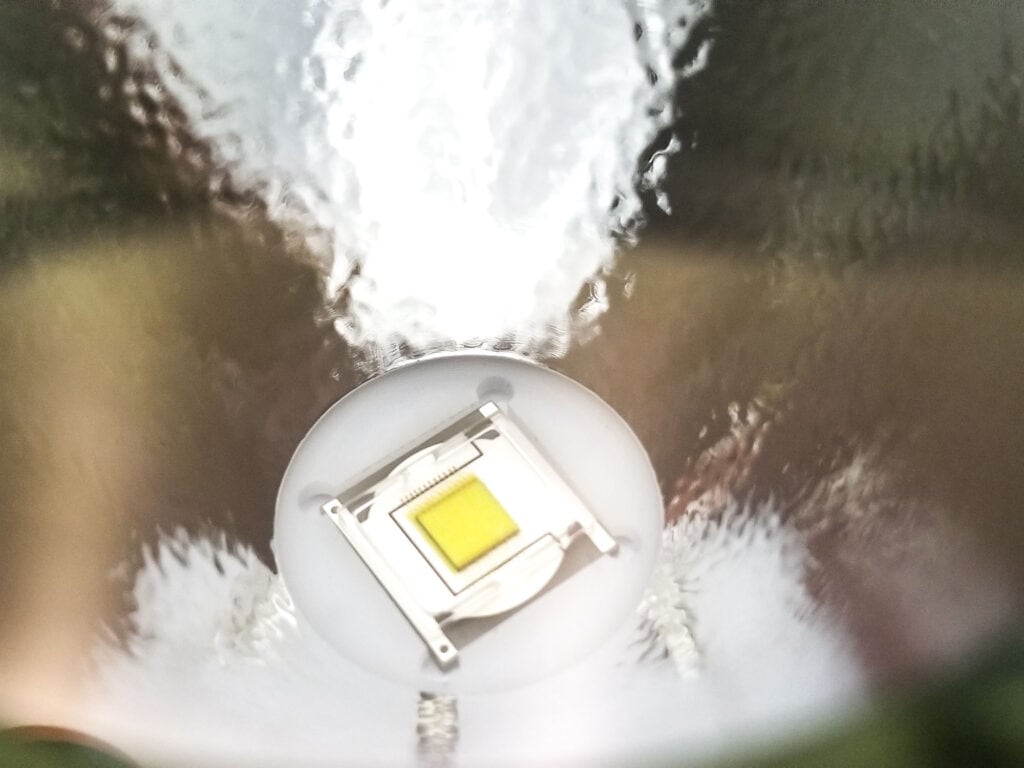
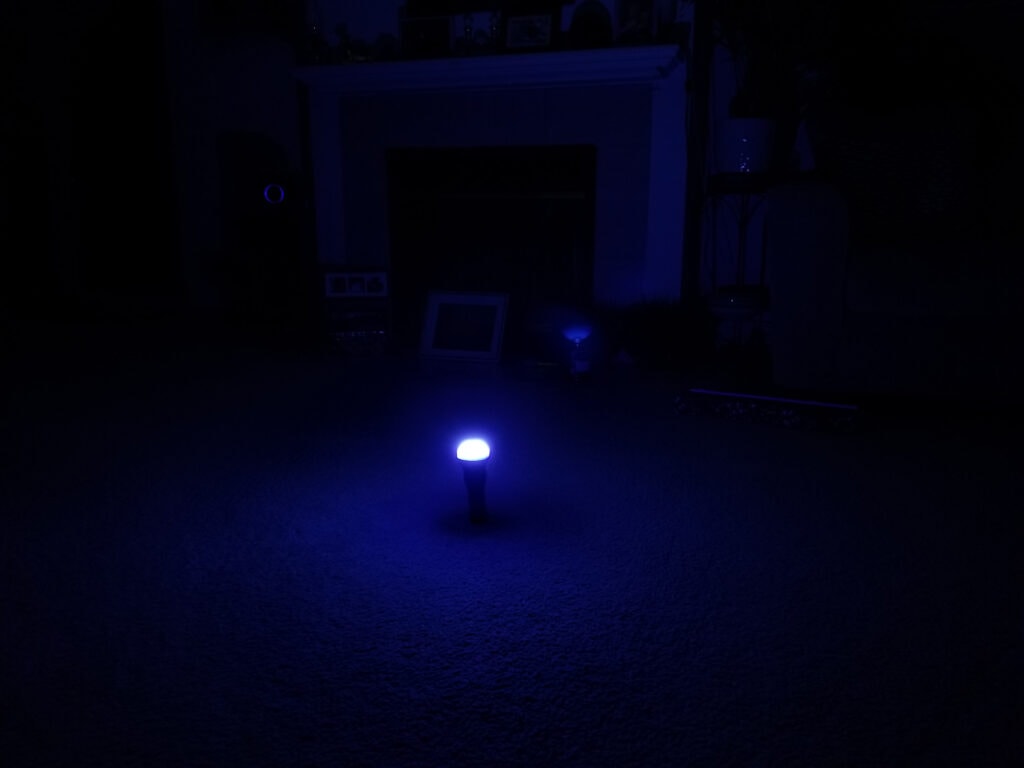
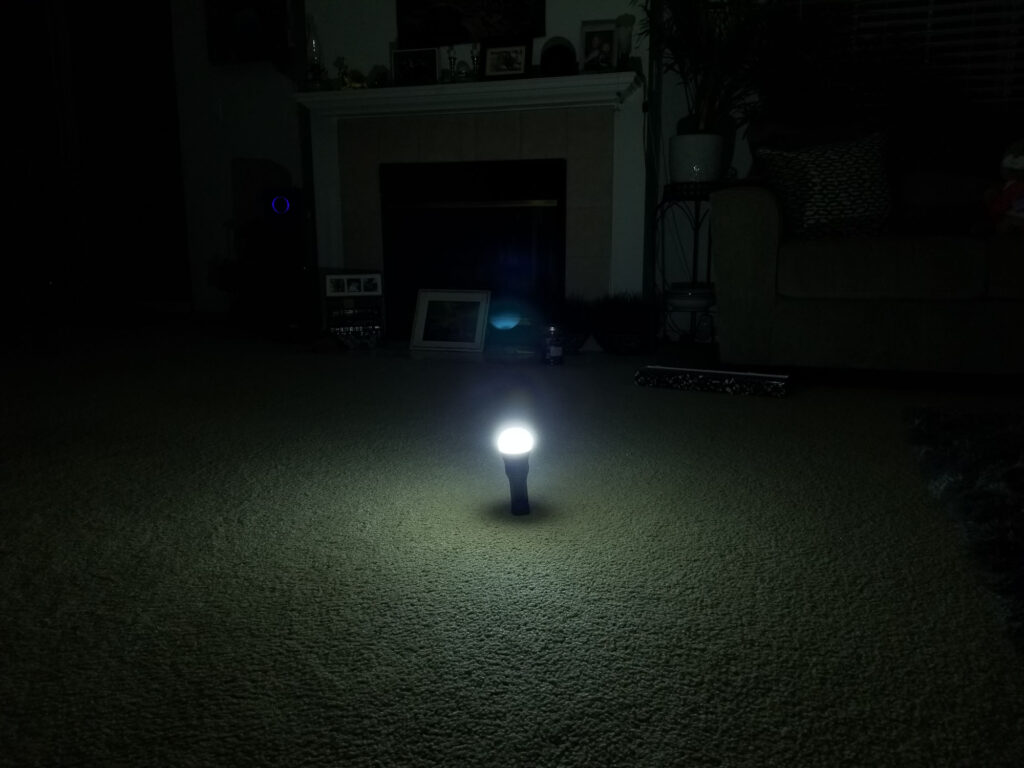
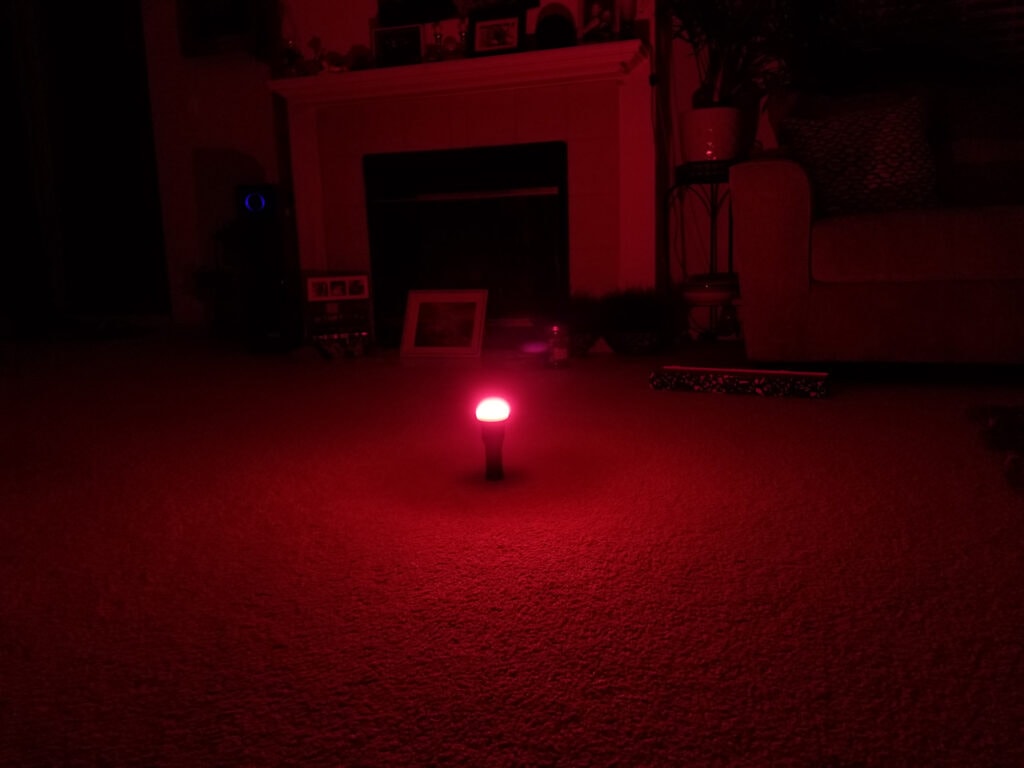
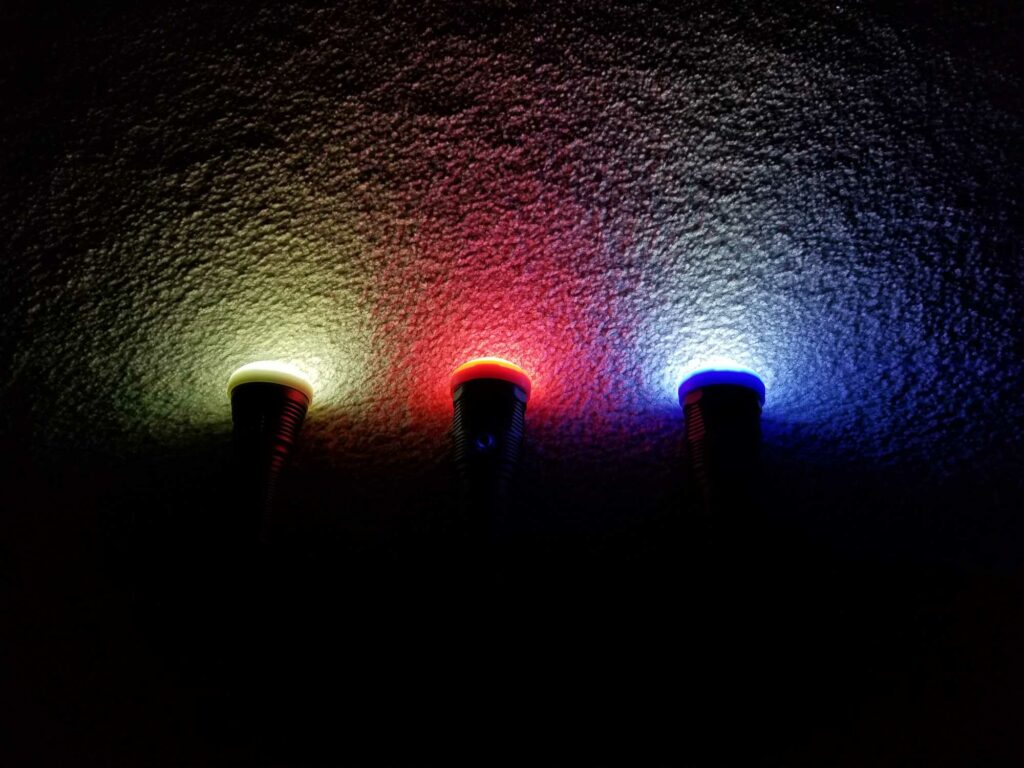
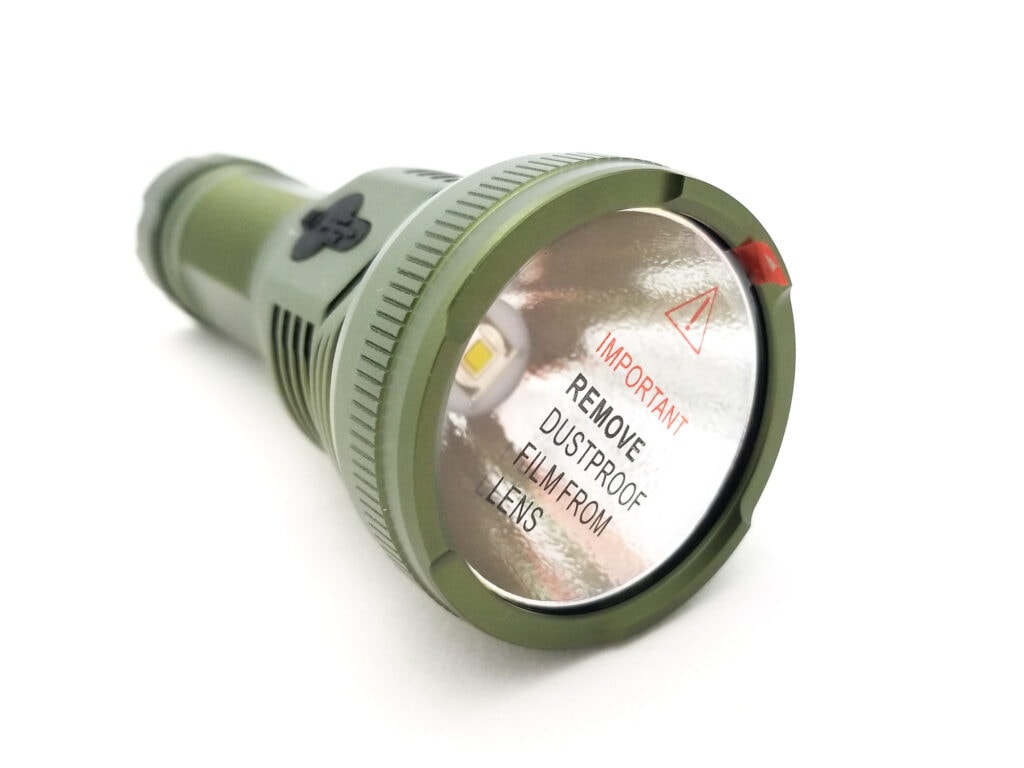
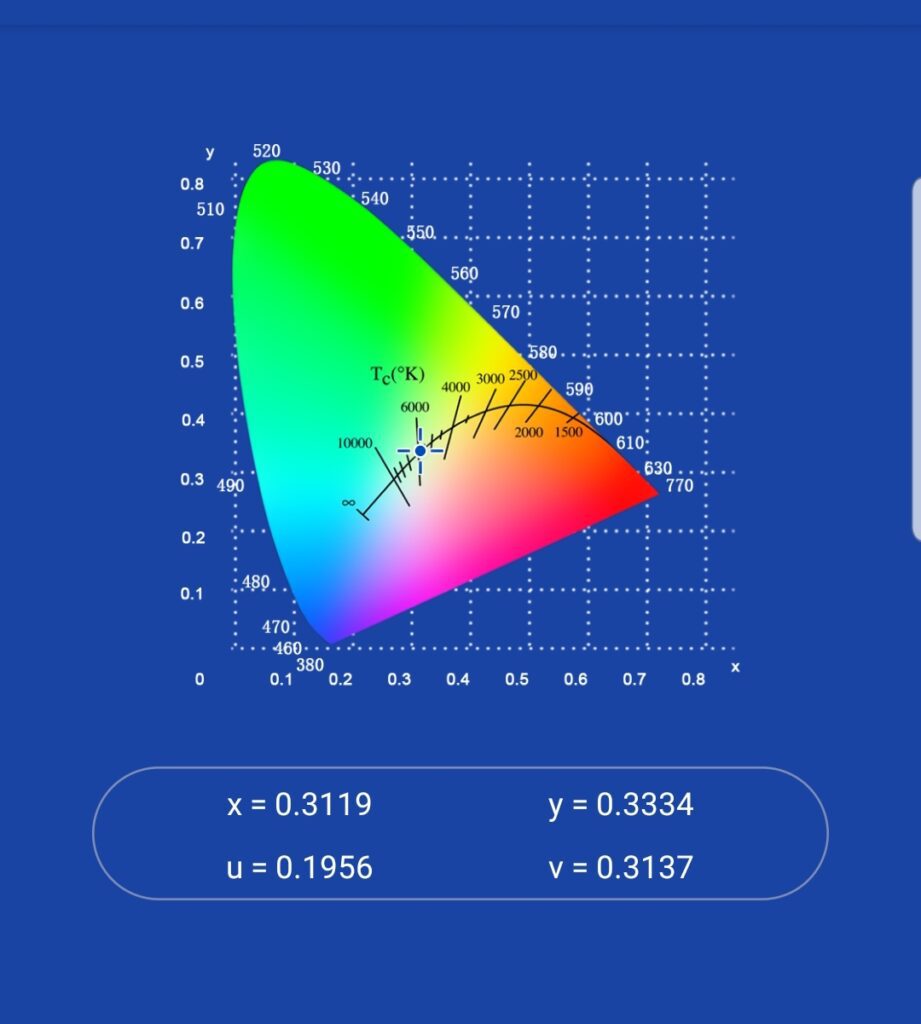
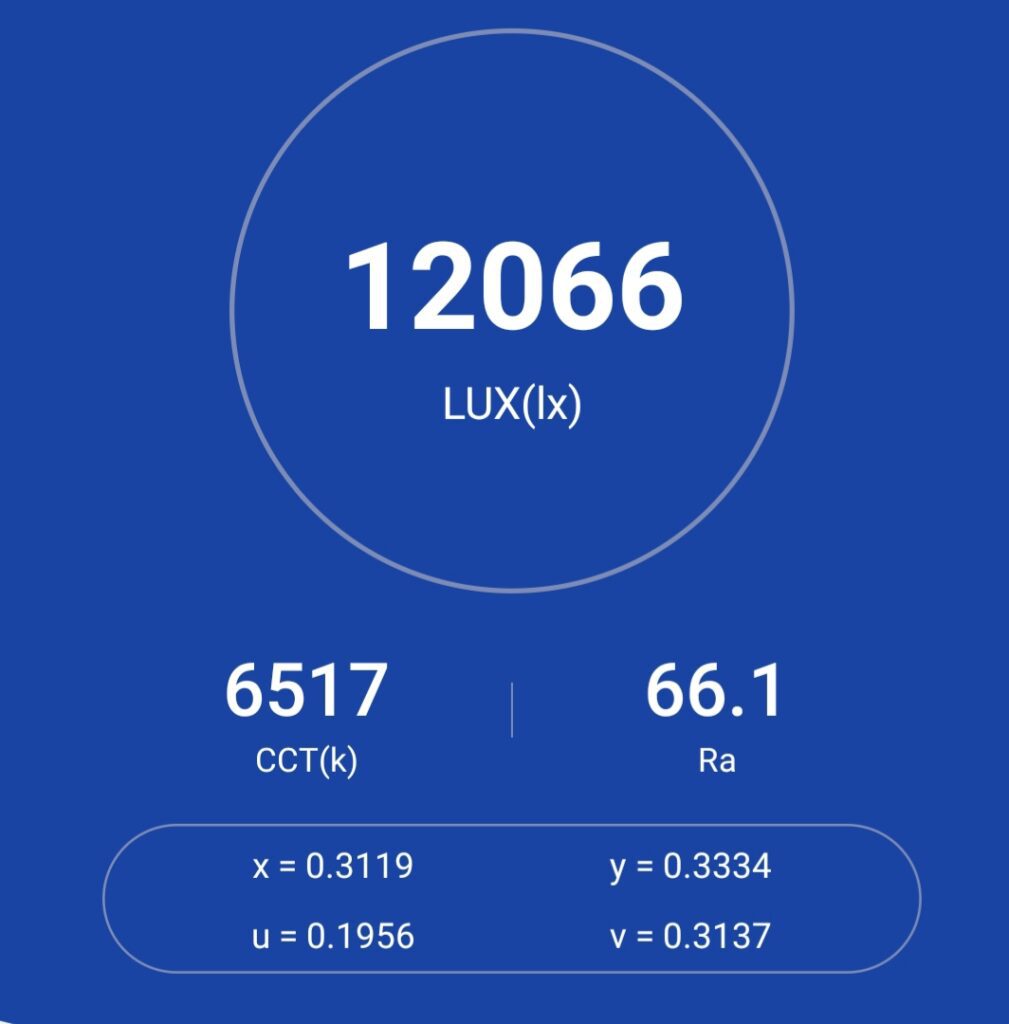
Dimensions and its competition
Dimensions:
| Mateminco MT-911 | Millimeters | Inches |
|---|---|---|
| Length (26650 tube) | 132 mm | 5.2 in |
| Length (26350 tube) | 100 mm | 3.9 in |
| Head diameter | 54 mm | 1.6 in |
| Body diameter | 34 mm | 1.3 in |
Dimensions are rounded to the nearest millimeter, and to the nearest tenth of an Inch.
Weight:
| Mateminco MT-911 | Weight in grams | Weight in oz |
|---|---|---|
| Without battery 26650 tube: | 200 g | 7 oz |
| Without battery 26350 tube: | 193 g | 7 oz |
| With Mateminco 26650 battery | 296 g | 11 oz |
| With 26350 battery | 238 g | 8 oz |
Weight is rounded to the nearest gram, and to the nearest tenth of an Oz.
Flashlight size comparison with its competition:
Group 1 left to right: Wurkkos TS30S Pro, Mateminco MT-911, Thorfire C8
Group 2 left to right: Wuben C2, Acebeam L18, Mateminco MT-911, Thorfire C8, Manker MC13 II SBT90.2
Group 3 reflectors left to right: Wurkkos TS30S Pro, Mateminco MT-911, Thrunite Catapult Pro
Group 4 left to right (a bunch of Astroluxes): Astrolux FT02S, Mateminco MT-911, Mateminco LT40, Astrolux EA01, Astrolux EC03, Astrolux MF01 Mini
Group 5: Mateminco MT911, Astrolux EA01
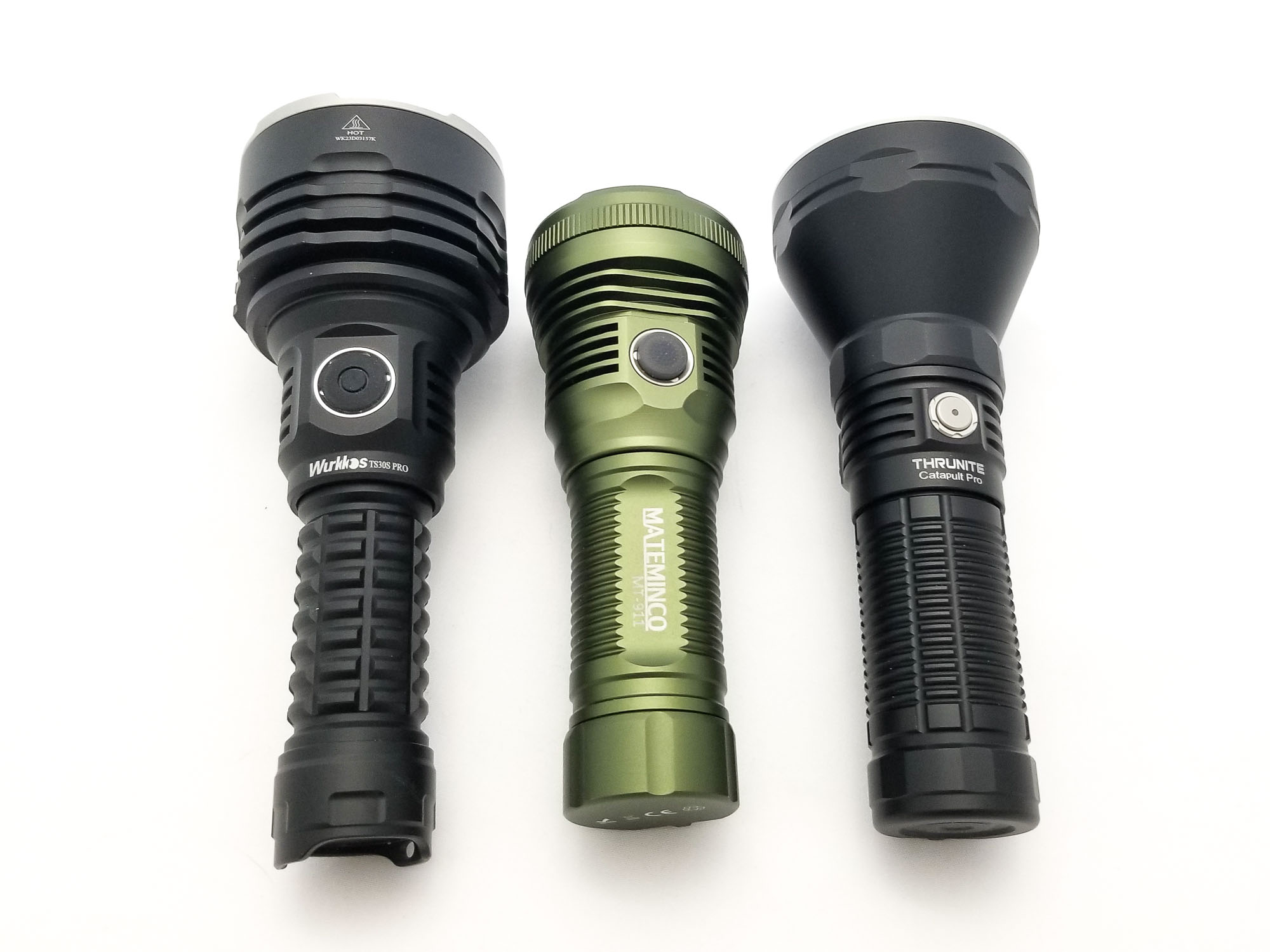
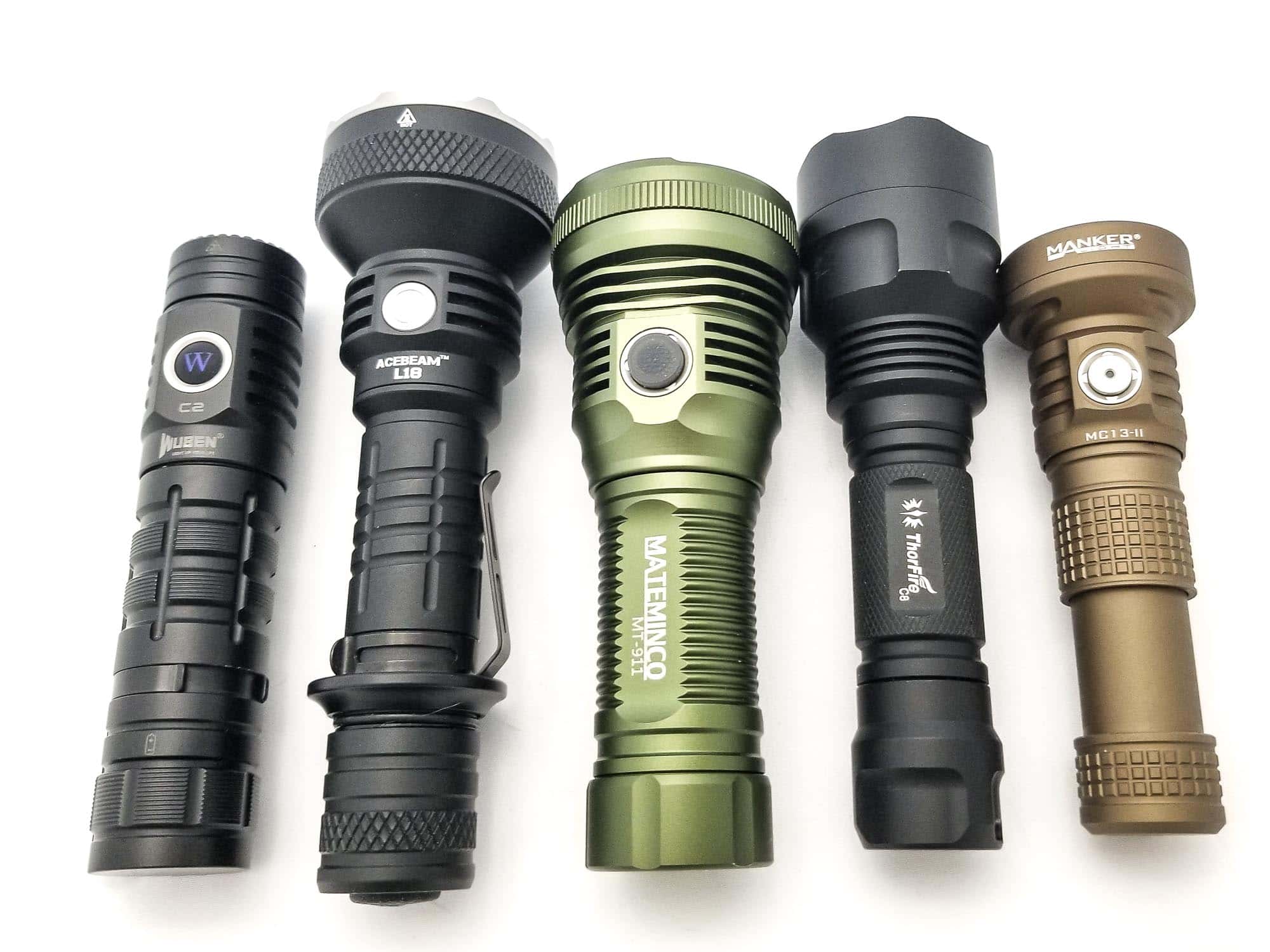
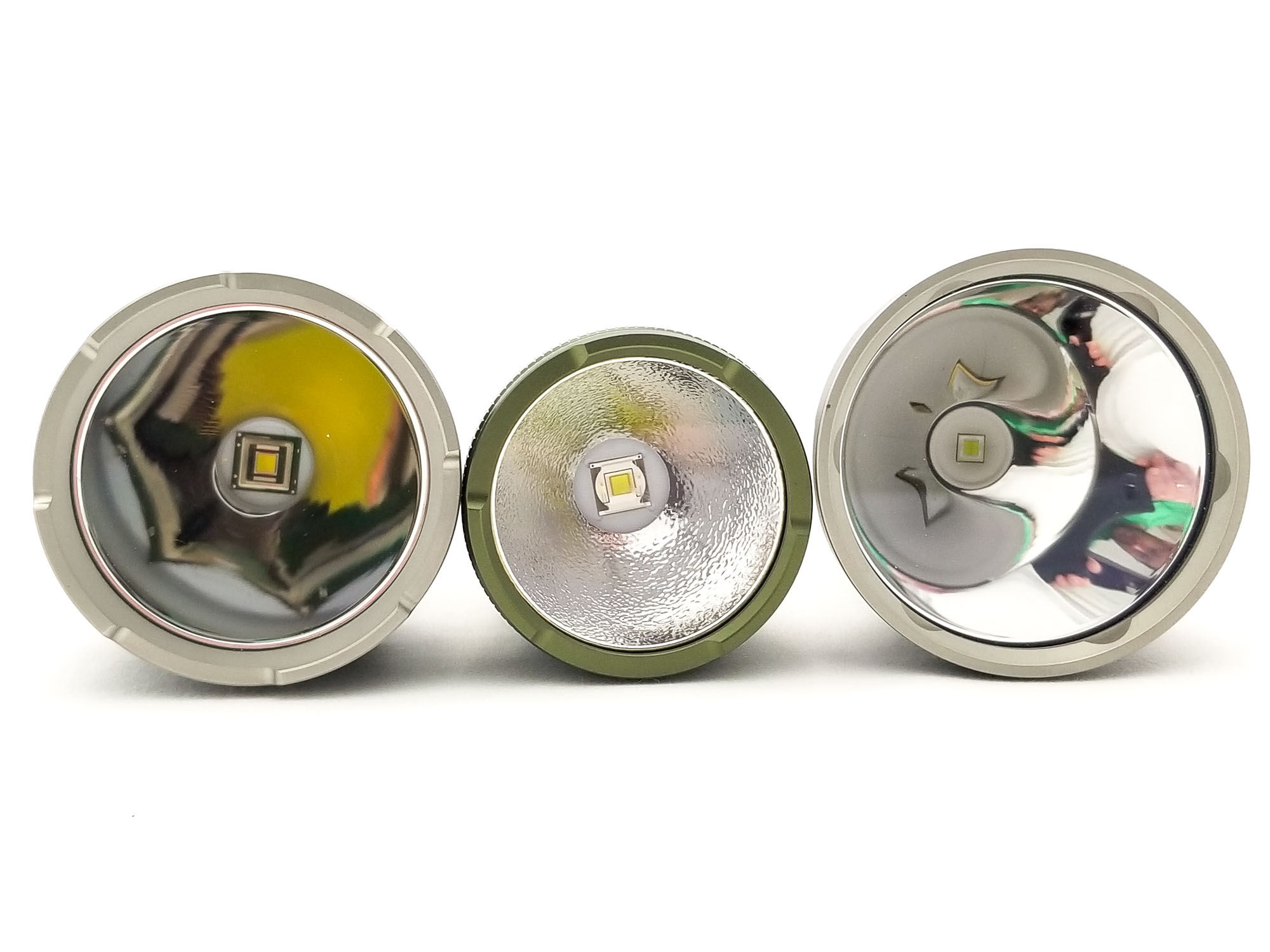
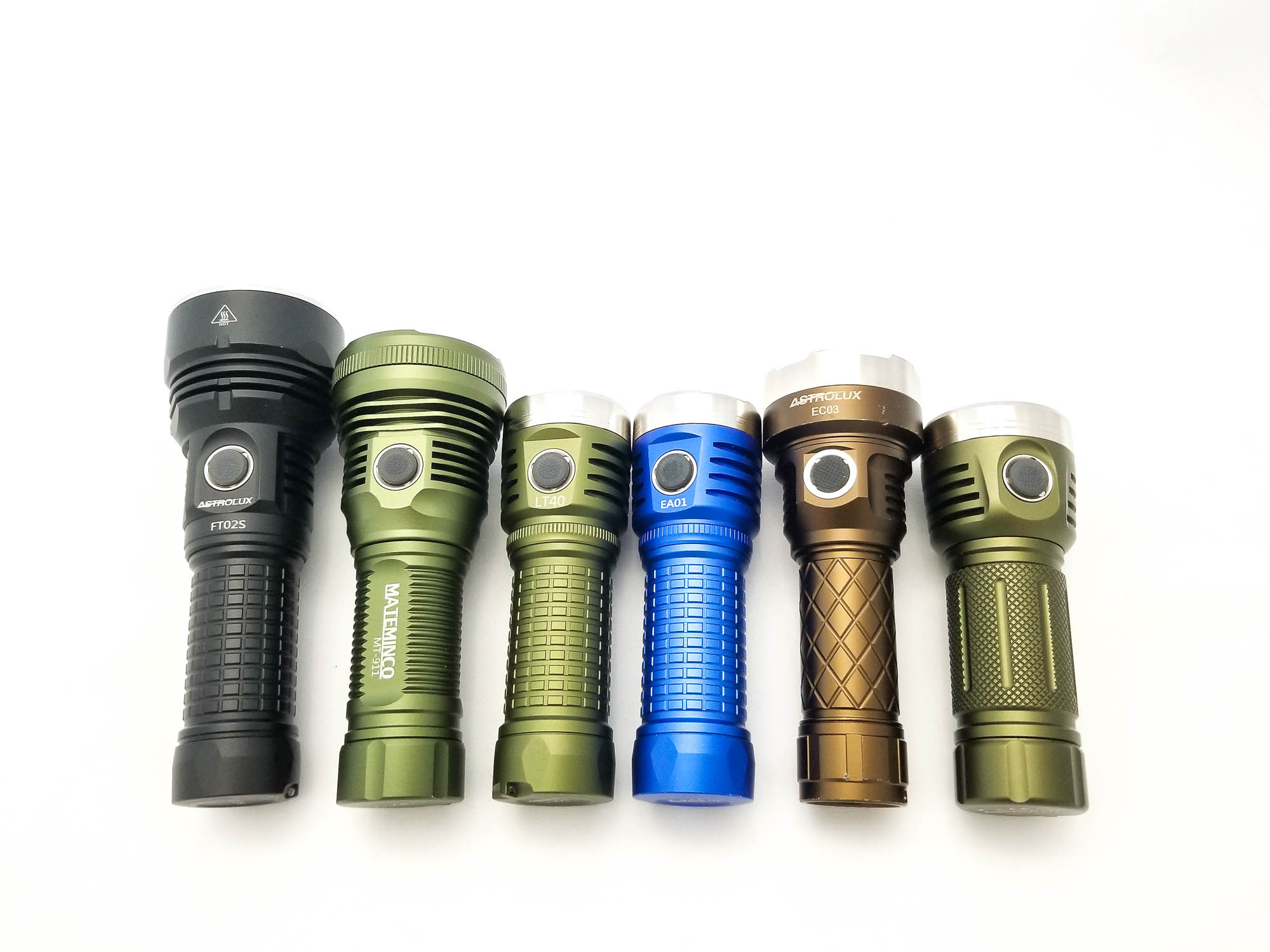
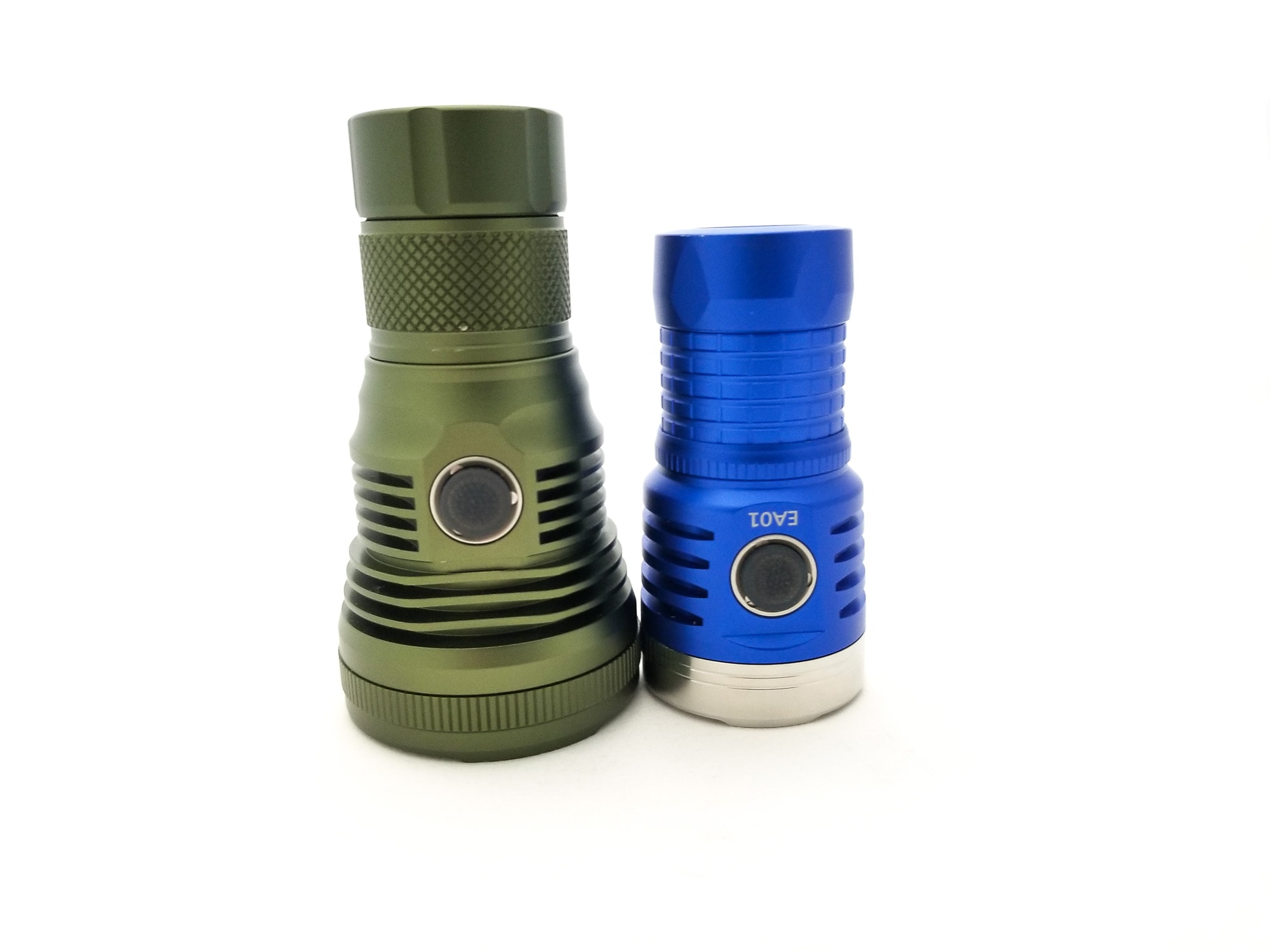
Mateminco MT-911 UI: User Interface and Driver
The driver is going to be a direct drive FET driver. There may be a 7135 regulator in there. This driver has test points, but is missing the familiar flashing pads we see on enthusiast-oriented Astrolux products with Anduril. It’s probably the same driver as the LT40, since externally, it’s identical. This is typical of these types of lights and helps them crank out the thousands and thousands of Lumens companies like to advertise.
The downside is the output isn’t regulated so it decreases as the battery drains unlike boost or buck drivers. The UI is unique, and like the LT40, I’m surprised it didn’t come with Anduril. This one comes with a more user-friendly UI that’s a bit like an extremely abbreviated version of Anduril. It’s a delightfully simple smooth ramping UI, but that’s all it does. This is the same UI as the LT40 I tested, and probably the same driver.
Available modes:
- Smooth ramping with Turbo.
Available blinky modes:
- Strobe
From OFF:
- Single click switch: Turns on in last memorized brightness setting
- Double click switch: Turbo
- Triple click switch: Strobe
From ON:
- Press and hold switch: Ramps up. Release and press and hold again to ramp down
- Single click switch: Turns off
- Double click switch: Turbo
- Triple click switch: Strobe
Mode memory:
- It remembers the last used brightness setting. Turbo and Strobe are not memorized
Shortcuts:
- Double click for Turbo
- Triple click for Strobe
Low voltage warning:
- The LED indicator shows battery state during operation, but no voltage association is listed for the color states, so here’s my best guess: Solid green 100% to 40%, solid red LED 40% – 15%, flashing red LED 15% – 1%. The light shuts off shortly after the switch starts blinking red.
Strobe/blinkies
- Strobe
Lock-out mode:
- None. Unscrew the tailcap ¼ turn to lock out manually
PWM
- Fast PWM not visible with the naked eye
Additional/summary info on the UI:
- This is a nice, simple and straightforward UI, again, unchanged from the LT40 I tested, and it’s pretty sparse feature-wise. While that’s fine for most users, this light is directed towards enthusiasts, and some might find it lacking as it’s missing some mainstream creature comforts like electronic lockout, stepped ramping, and batt check. No Anduril also means no calibrating the thermal sensor or adjusting the thermal limit either, something we all take for granted with Anduril. There’s no mention of temperature regulation in the instructions, and I’m sure it probably has it. I wasn’t impressed with the ATR on the LT40, nor the super-quick step downs, so maybe Mateminco has tweaked it somewhat for this light now that it doesn’t have to drive 4 powerful LEDs?
Mateminco MT-911 Charging and batteries
Like just about every single Astrolux/Mateminco pocket light in existence, the MT-911 is designed around a 26650 size battery. The 26650 size battery, while still somewhat relevant, have really been overshadowed by 21700 size batteries, which are smaller in diameter, lighter, and can have much better current handling.
The light can also accommodate the stubby 26350 battery as well with the short tube installed. The long tail spring is there for a reason, and it’s to take up the extra 7 mm or so of extra space in the tube, so a protected 26650 would fit just fine.
For added versatility, if you’ve got an Astrolux EA01/EA01S, FT02S, MF01 Mini, or the equivalent Mateminco with the 21700/18650 adapter, it will fit this light also, and that means it can run 21700s. The optional 26800 tube will also fit, so there’s (potentially) tons of battery options available for the MT-911. Alas, if only the adapter tube was not included with this light (it isn’t). The light included both a Mateminco branded 5000 mAh flat top 26650, and a Smurf blue, mystery brand flat top 26350 battery. This cell format is a bit of a superfluous at only 2000 mAh, so you won’t get good runtimes, and sacrifice size and portability for output and runtime. The light has onboard USB type C charging, and Mateminco says it’s good for up to 2 amps. I’m seeing around 1.8 amps on USB A to C, and about the same on C to C, so not super fast charging, but should charge a big 26650 in around 3 hours.
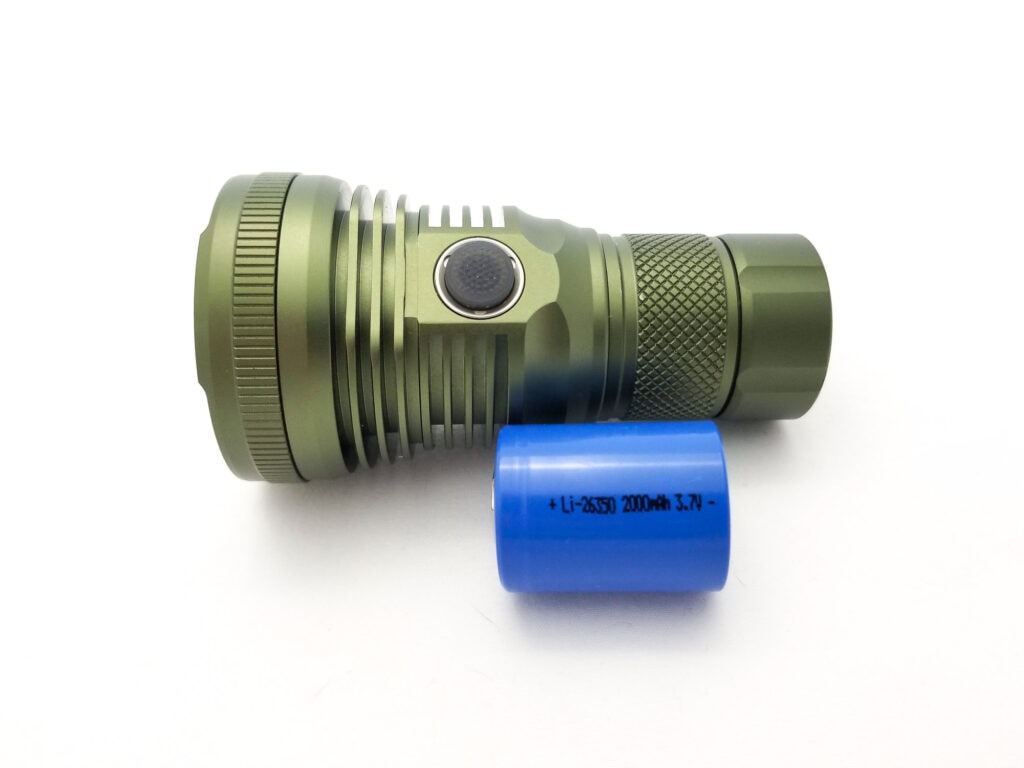
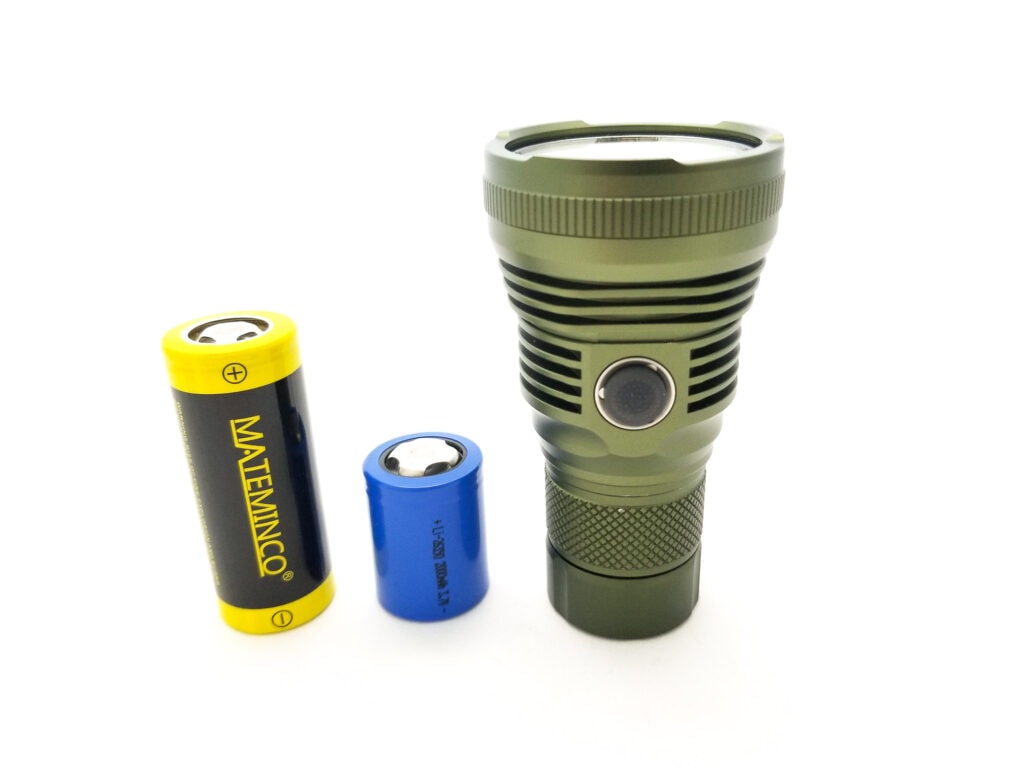
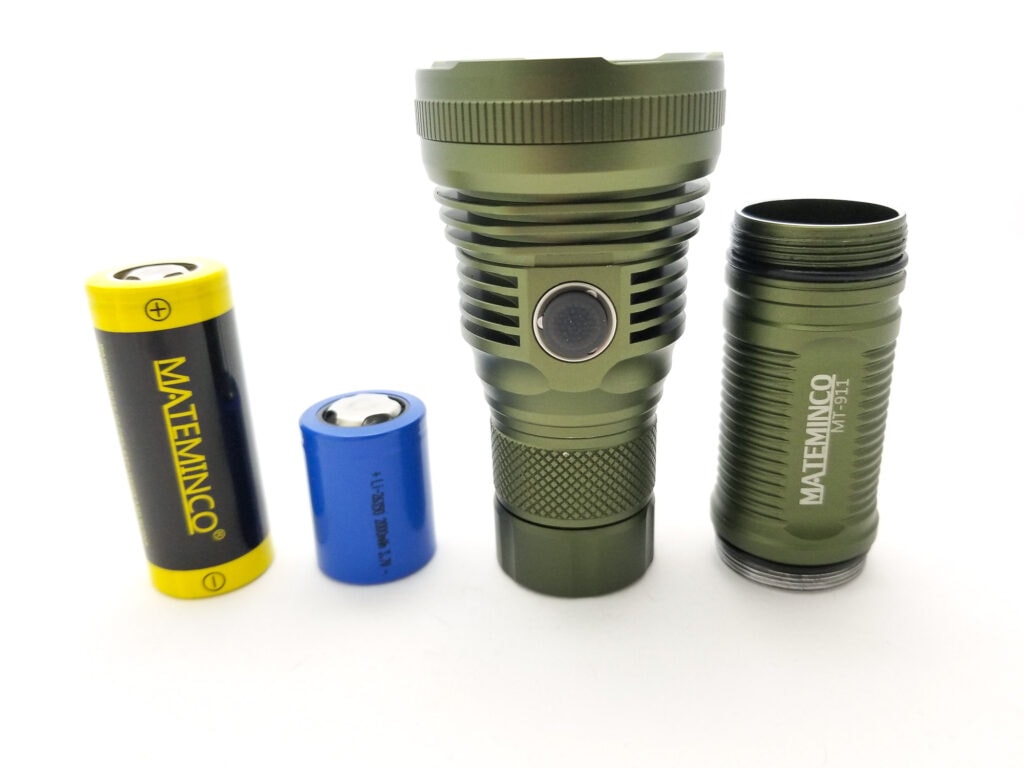
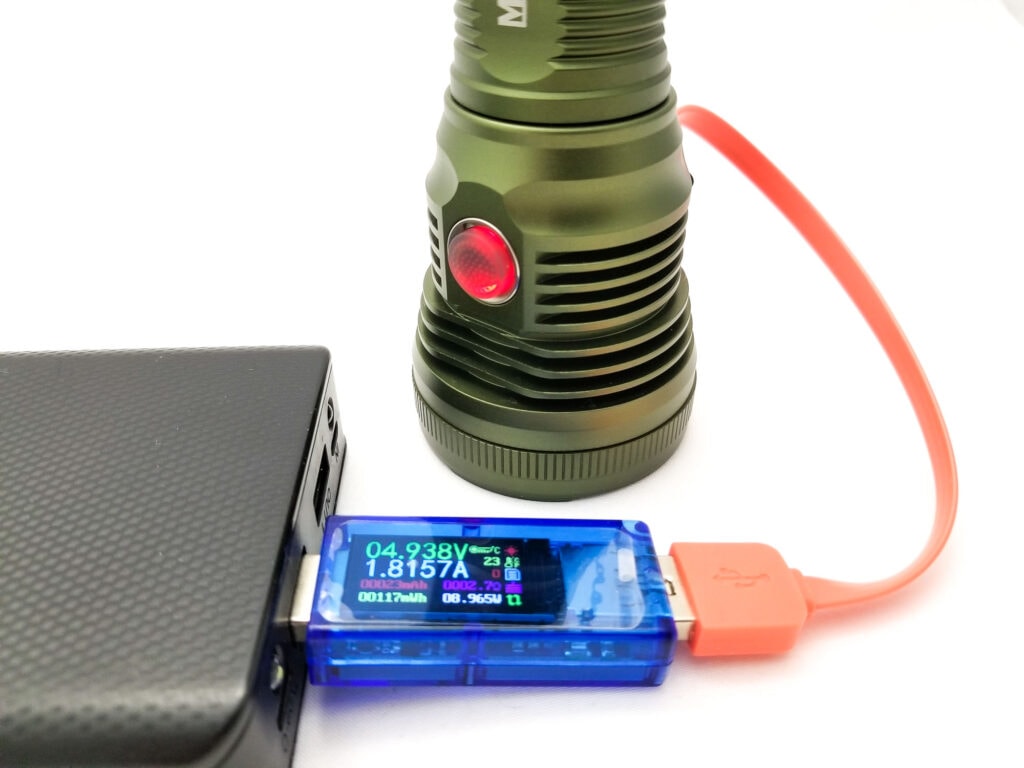
Performance test
Lumen measurements
How Lumens are Measured: Understanding ANSI FL1 Standards How Lumens are Measured: Understanding ANSI FL1 Standards: The ANSI FL1 standards specify that output in lumens should be measured 30 seconds after turning on, as this is the standardized time for measuring brightness according to the industry standard. This is why we focus on this part in our measurements. The ANSI FL1 standards require an ambient temperature of 22 ± 3°C. We record the ambient the ambient temperature to identify potential reasons for any observed discrepancies.Lumens are measured in my 50 cm integrating sphere with a Digi-Sense 20250-00 data logging luxmeter. The sphere has been calibrated with a Convoy S2+ measured to 260 Lumens and the figures are within 10% of actual. I measured current with my Thinside B18B+ multimeter with 14 gauge wires directly in the meter on banana plugs, and my FY219 clamp meter with a 12 gauge wire in a loop. Measurements were taken using the fully charged Mateminco 5000 mAh 26650. I also ran Turbo with the 26350. I tested the bottom of the ramp, what looked like mid (50%) ramp, top ramp, and Turbo.
| Mode | Amps | Specs | turn on | 30 sec | 10 minutes |
|---|---|---|---|---|---|
| Bottom of ramp | 7 mA | ? | 1.2 lm | 1.2 lm | – |
| Mid ramp | Not measured | ? | 578 lm | 503 lm | 578 lm |
| Top of ramp | 9.8 A | ? | 1956 lm | 578 lm | 467 lm |
| Turbo | 17.9 A | 6200 | 2952 lm | 1722 lm | 467 lm |
| Tubo 26350 | 13.6 A | ? | 2608 lm | 1341 lm | 394 lm |
Specs for this light are nonexistent except for Turbo at 6200 Lumens. I can’t say I’m not surprised here since to get 6200 Lumens out of an SBT90.2, you’re going to need to feed it aout 26+ amps and you need a mighty stout thermal path and at least 3 high-end 21700s in parallel to do it. This analog 90.2 simply can’t produce that kind of output, never mind on 18 amps. I didn’t measure the current for the mid ramp since getting a consistent measurement was so tricky. Since you don’t get the adapter tube with the light, I borrowed one from the Astrolux EA01 and tried some 21700s to see how it affects the current. I also tried it with the 26350, and there wasn’t much of an output deficit, but the tradeoff is about half the runtime and lower sustained output.
Some current figures with various 21700s (at start):
- Samsung 30T: 22.5 A
- Samsung 50S: 22 A
- Molicel P42A: 18.5 A
- Nealsgadgets Lishen LR2170HP: 22.9 A
It looks like this LED is just about pulling the same current as a genuine SBT90.2, so my guess is it’s got a bit worse thermal resistance, so it’s less able to take advantage of lower resistance battery. Even so, that chooch is very short-lived due to aggressive thermal throttling, so it’s just about pointless to use a higher-power battery.
Parasitic drain:
- 0.12 mA
Mateminco MT-911 battery Life: Runtime graphs
How Runtimes are Measured: Understanding ANSI FL1 Standards About ANSI FL1 runtime standards: The runtime is measured until the light drops to 10% of its initial output (30 seconds after turning on). This does not mean that the flashlight is not usable anymore. The last column shows how long the light actually works till it shuts off. If there is a + symbol, it means that the test was stopped at that particular point, but the light was actually still running. This happens on certain occasions, with certain drivers, firmware, or batteries.Lumens are measured in my 50 cm integrating sphere with a Digi-Sense 20250-00 data logging luxmeter. The sphere has been calibrated with a Convoy S2+ measured to 260 Lumens and the figures are within 10% of actual. I used the fully charged Mateminco 5000 mAh 26650 and the 2000 mAh 26350, and tested 50% (or what looked like 50%), top of ramp, and Turbo.
| Mode | Specified | Measured runtime ANSI | Time till shut off |
|---|---|---|---|
| Mid ramp | ? | 3h 4min | 3h 4min |
| High (Top ramp | ? | 3h | 3h 7min |
| Turbo | ? | 2h 43min | 2h 58min |
| Turbo 26350 | ? | 1h 23min | 1h 32min |
As suspected, this looks like the exact same driver as the LT40, along with the same thermal management algorithm. I can’t say that I’m impressed with these runtimes, or the output graphs. It’s sort of disappointing given the somewhat-decent heat sinking and 5000 mAh 26650 battery, so I think the MT-911 has more to give, but again, this LED probably isn’t the most efficient thing out there.
What’s particularly disappointing is that the stepdowns are dramatic and surprisingly quick, coinciding with what seems to be an equally surprisingly low thermal threshold. The light started throttling back on High and Turbo after only 15 seconds, down to about 20% of the starting output by 30 seconds at only 38 C per the non-contact thermometer. Interestingly, after the step down, all three modes (Turbo, High, and 50%) all tracked exactly the same after about 60 seconds.
The thermal mapping also needs work, and while it didn’t go on a see-saw pattern like I see with some other lights, it remained very Anduril-like, leveling out at about 500 Lumens with the temperature rising to about 56 to 60 C over about 30 minutes.
It heats up pretty slow, but the output stays low. Switching to the 26350 battery results in the same output curve with a slight Lumen deficit at the top end, but the same step down and a truncated runtime (down about an hour from the 26650). You get a fairly decent amount of light for over 2 hours on Turbo and High, and you can call up Turbo with a double-click any time. Also, turning the light off and on after the step down on High mode reactivates full brightness. The light was usable after each test at lower modes though, and the battery was sitting at 2.89 to 3.1 volts after each test.
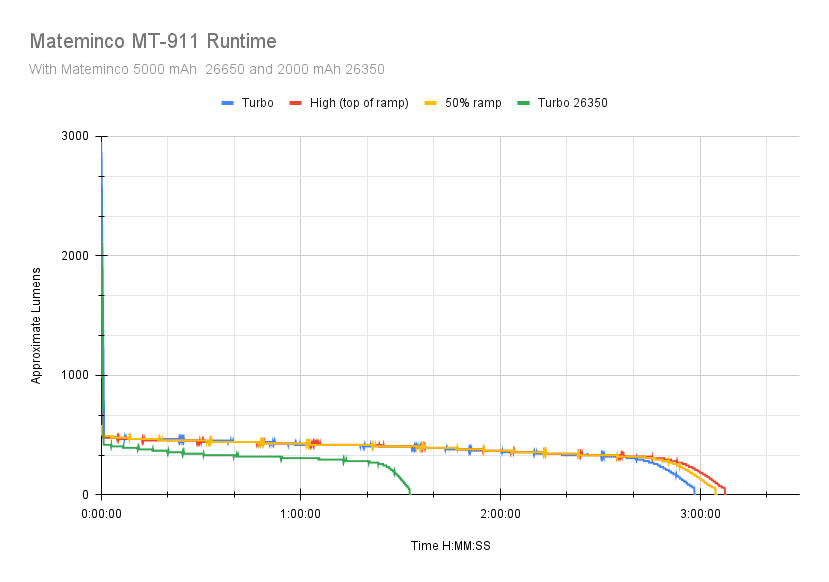
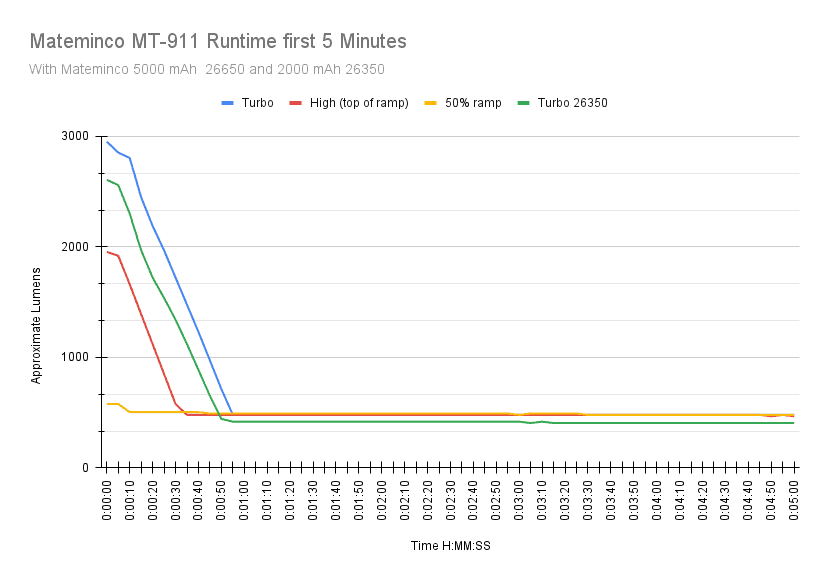
And here’s some comparisons with other flashlights
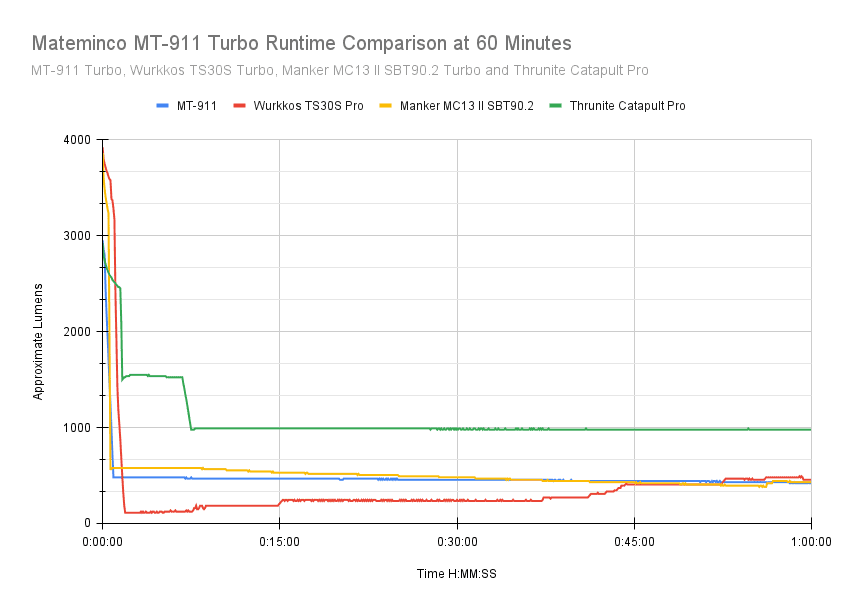

Peak beam intensity and beam distance measurements
About Peak beam intensity: Understanding ANSI FL1 Standards About peak beam intensity The calculated value of distance in meters at which the flashlight produces a light intensity of 0.25 lux. (0.25 lux is about the brightness of a full moon shining on an object). This means that the intensity has decreased so much, it becomes difficult to see darker objects, or objects that don’t reflect light. The columns ‘Meters’ and ‘Yards’ use rounded numbers.Beam distances are measured using a Uni-T UT383S luxmeter measured indoors at 5 meters using the included fully charged Samsung 50S battery. Measurements taken at 30 seconds.
| Mode | Specs | Candela measured | Meters | Yards |
|---|---|---|---|---|
| Bottom ramp | ? | N/A | N/A | N/A |
| 50% mid ramp | ? | 17,725 | 266 | 291 |
| Top ramp | ? | 33,900 | 368 | 402 |
| Turbo | 210,000 cd | 61,050 cd | 494 m | 540 yd |
| *Turbo at start* | *121,700* | 698 | 763 |
There’s not much in the way of specifications for the MT-911, and Mateminco doesn’t list it on their product page, and Flashlightbrand only lists s single throw figure of 210,000 cd and 916 meters. Low was too low to measure at 5 meters. Not surprising that my throw figures are as disappointing as the output figures.
Beamshots
I compared the Mateminco MT-911 to some other multi-LED high output flashlights. Photos taken with my Samsung Note 8. The 95 meter shots with the camera set to 0.3s ISO 200 and 5000K WB.
Beamshots of the following flashlights compared:
- Mateminco MT-911
- Wurkkos TS30S Pro
- Amutorch XT60 NB90.16
- Manker MC13 II SBT90.2
- Acebeam P17 Defender
- Lumintop D3






Disclaimer: This flashlight was sent to me for review at no cost by Flashlightbrand. I have not been paid to review, nor have I been holding back on problems or defects.
Final Verdict
Pros
- Nice build quality
- Good handling
- Compact
- Simple ramping UI
- Onboard USB type C charging
- 26350 battery compatibility
Cons
- UI is a little too basic
- Very fast step downs from top ramp and Turbo
- Temperature regulation needs adjustment
- Unimpressive output and runtime
- Didn’t meet advertised specifications for throw or output
Explanation on star ratings:
1: Avoid: a match would be a better choice – 2: Poor: significant defect or issues; almost unusable – 3: Average: some defects or issues; but still usable 4: Good: recommended (minor issues) – 5: Great: highly recommended

3 stars: ★★★
While our star rating provides a reliable indicator, we encourage you to read the full review to make an informed decision based on your own needs and preferences.
Unlike the LT40 I tested, this Mateminco MT-911 is an entirely new design, which is good, and I really like this host. It’s good-looking, compact, relatively lightweight, and has good handling. The LED is a clone of the most awesome thrower LED on the market as well. First impressions were great. Solid build quality, good fit and finish, nice handling, onboard charging, and the quirky 26350 battery tube was included this time. You could also thread on Mateminco/Astrolux’s 26800 battery tube for some 26800 action.
That’s where the niceties end though, since the rest of the MT-911 is pretty unremarkable. Underneath, the electronics have been lifted from the LT40, along with the UI. While I like simple UIs, this one’s pretty sparse, a bit too sparse even, and lacks basic features found on other modern flashlights. The same way-too-quick thermal regulation is present from the LT40, so the light never gets a chance to heat up before stepping down, so the sustained output (and the runtimes) aren’t great.
Moreover, it didn’t meet the performance specs either, and was down about 50% on both throw and output. Why Mateminco didn’t give this an SMO reflector is beyond me, since it would have helped the candela figures a bit. Maybe this XLD-G90 LED has a bad beam that needs help from the OP reflector? As much as I like the MT-911, I think it needs improvements to make it a better-performing light. Tweak the thermal management algorithms, and improve the driver, and Mateminco would have a great flashlight. As it is though, I give it 3 stars. It’s adequate, but not a stand out.
Mateminco MT-911 for sale?
Note: August 2023: WARNING: don’t buy from flashlightbrand.com!!!
We received questions whether flashlightbrand.com is still legit, because they either didn’t respond, or didn’t receive their orders. We tried to reach out multiple times, through multiple platforms, and they never replied to any of our messages. Warned: DO NOT BUY FROM FLASHLIGHTBRAND.com, because you will not receive your flashlight
1lumen selects and reviews products personally. We may earn affiliate commissions through our links, which help support our testing.